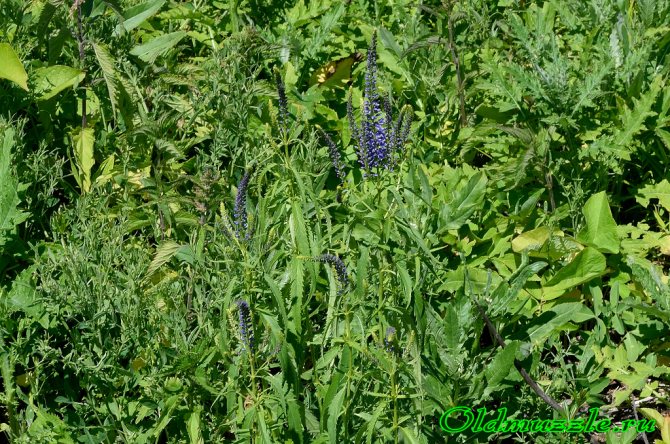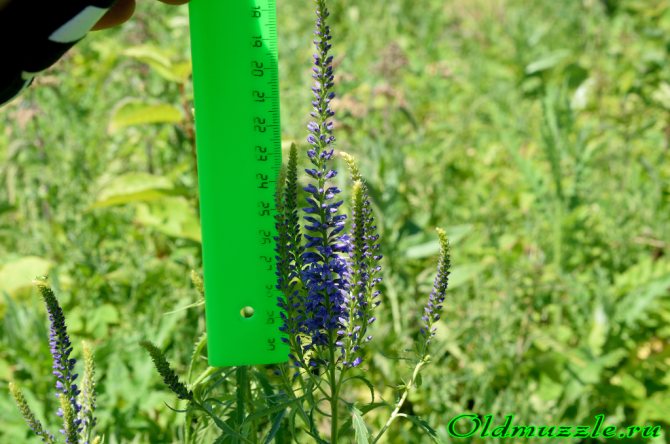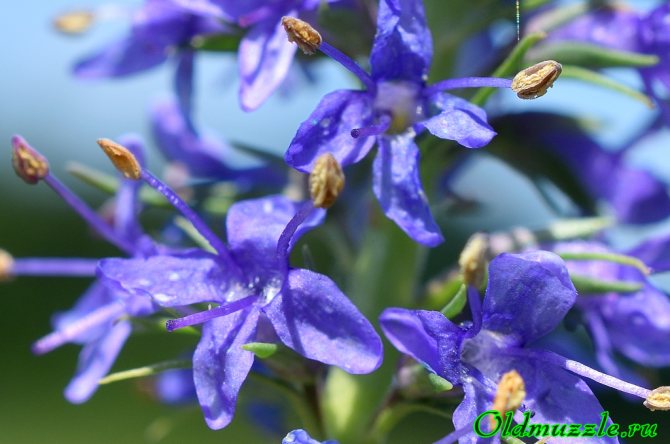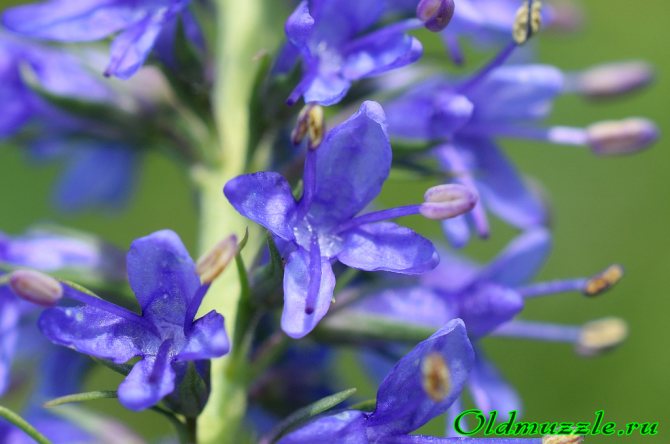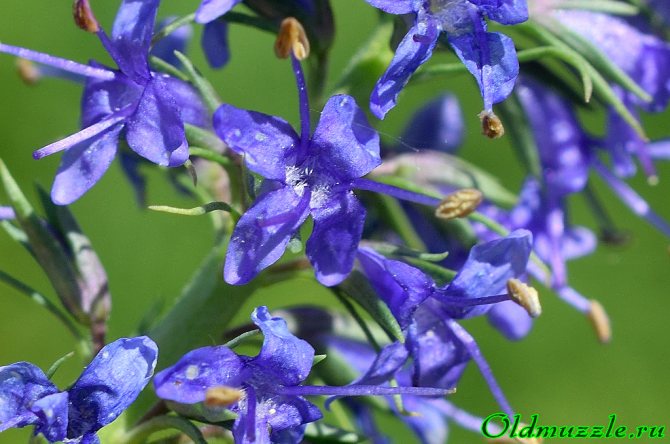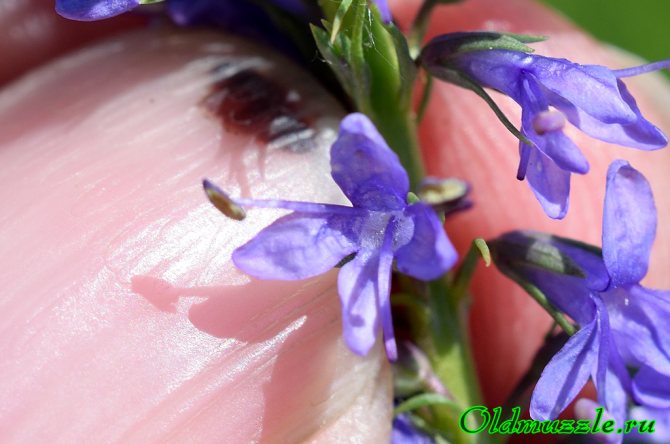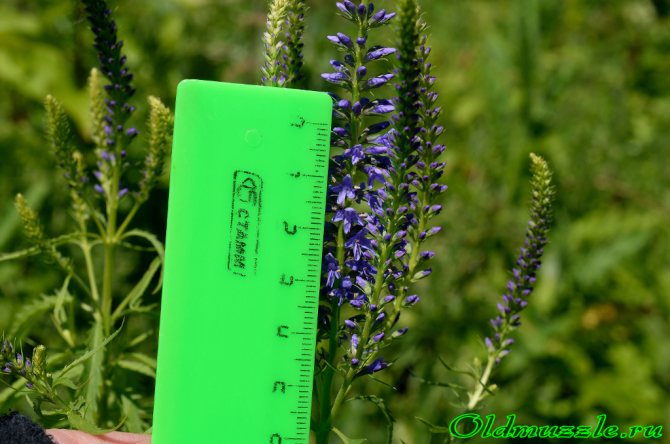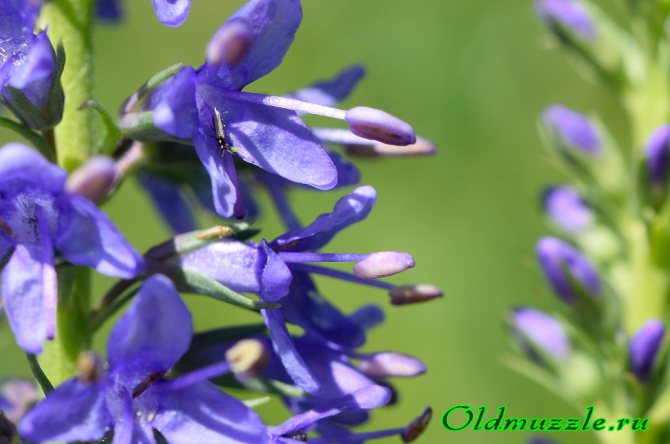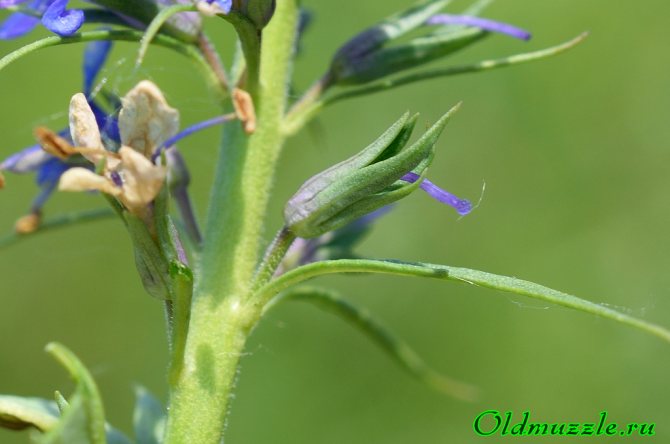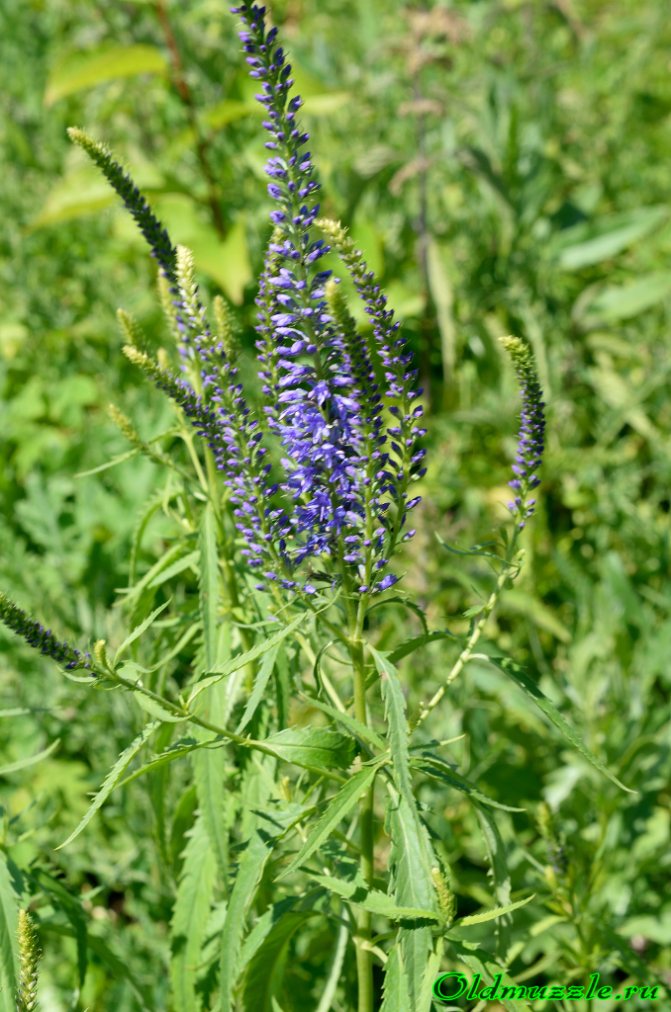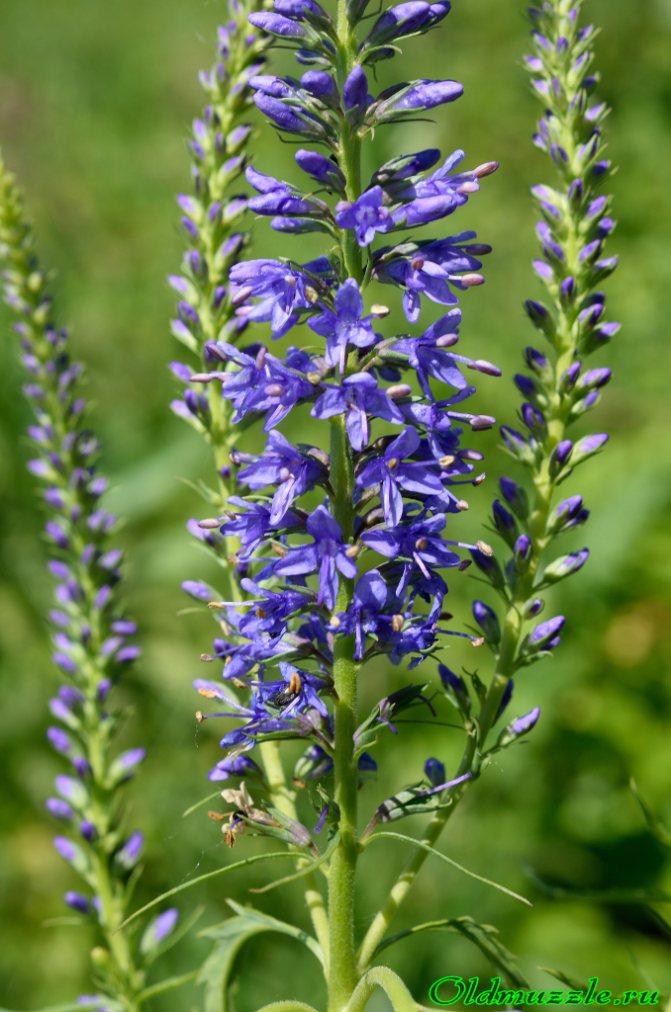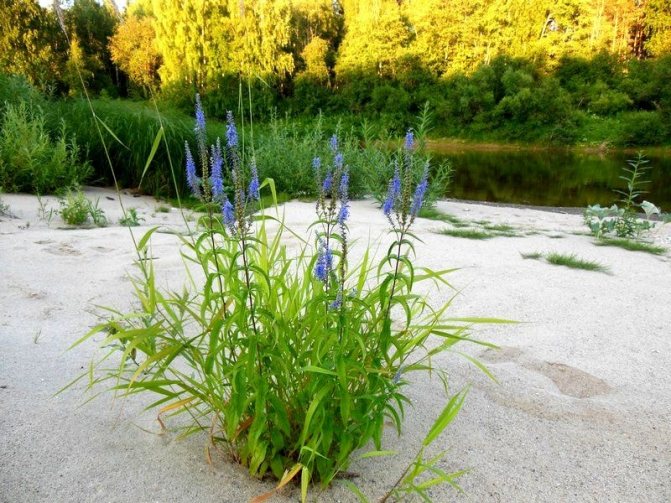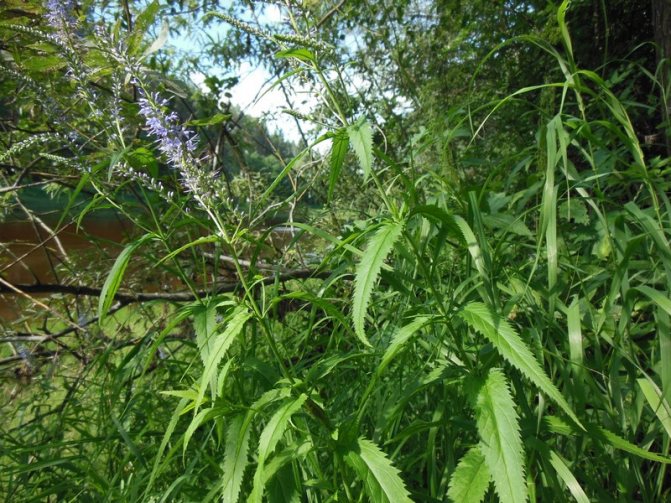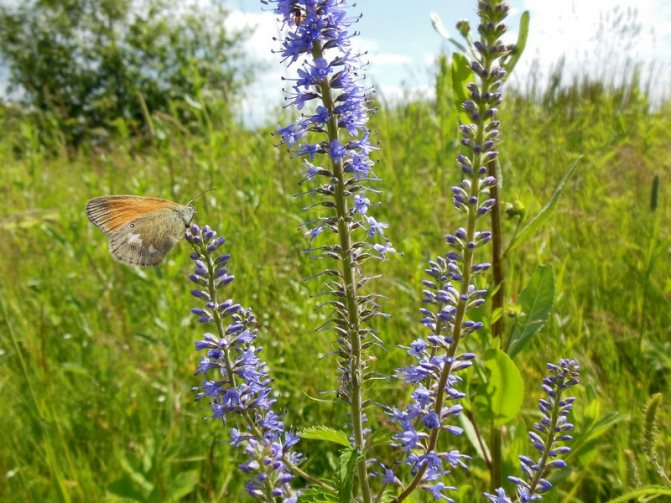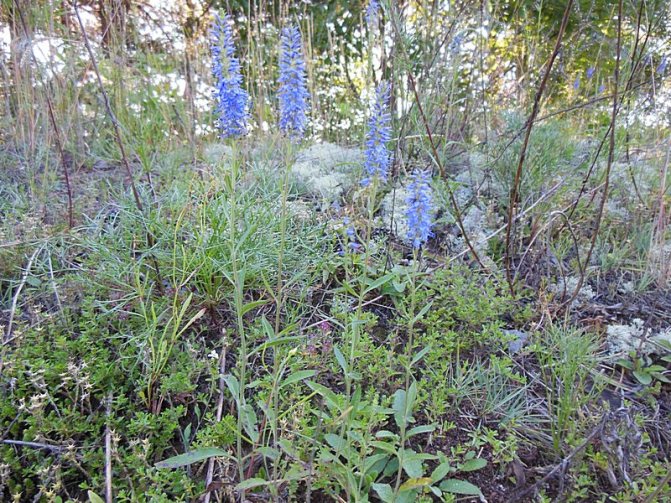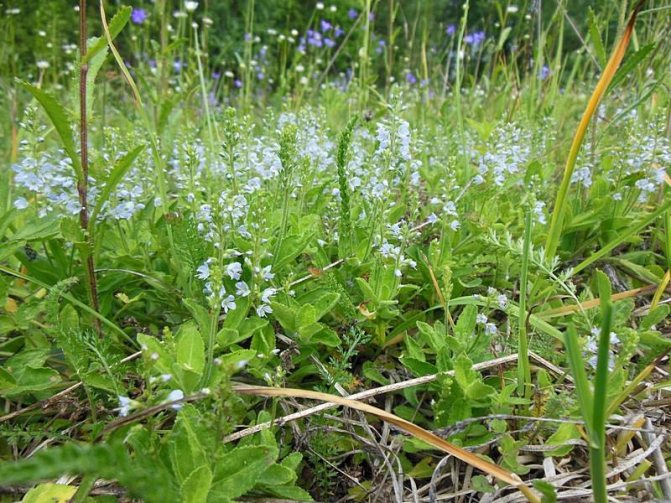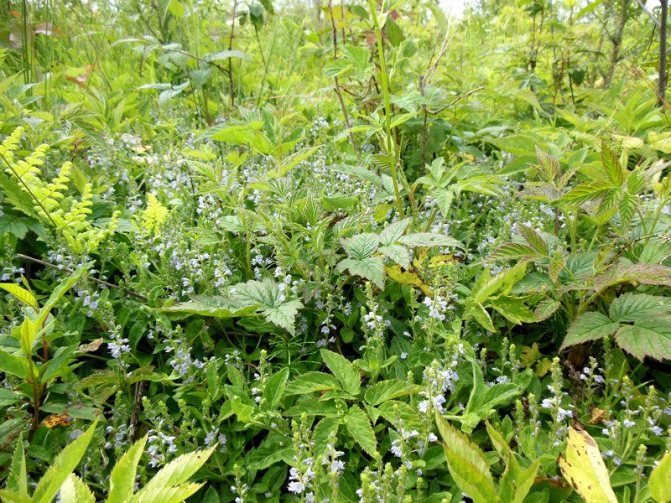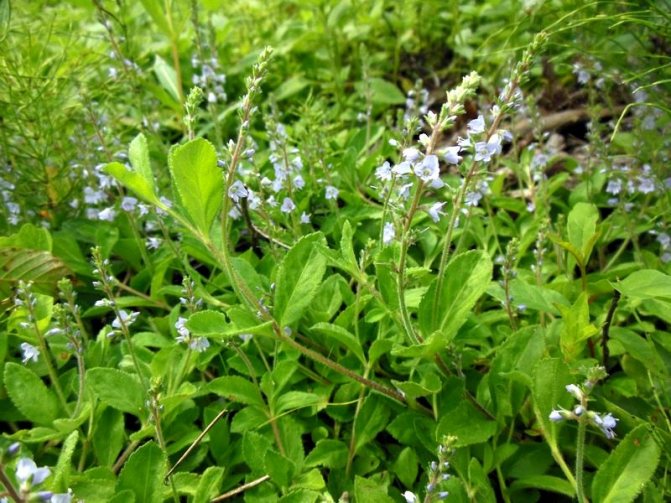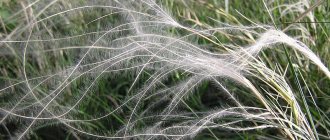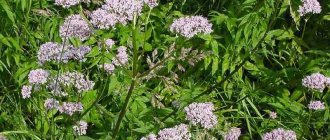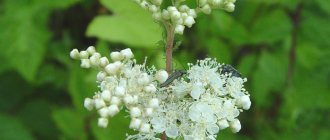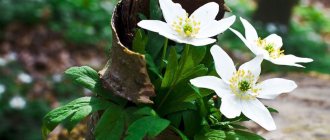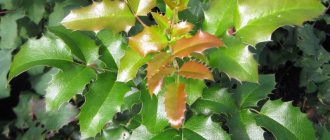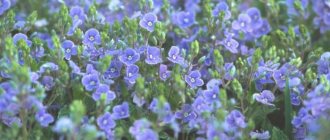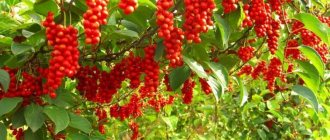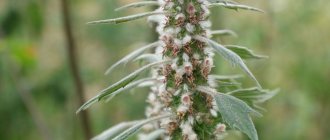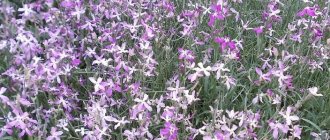Veronica will become a welcome guest in any garden thanks to the sky blue, bright blue, delicate purple colors. The flower is also unpretentious, and the variety of species and colors is amazing. It looks good in the garden in large groups, you can plant it in rock gardens and rockeries, decorate a pond, make a blooming lawn. I tell you how to grow this decorative flowering herb in this article, I give examples and photos of varieties.

Description of the plant
Veronica spikelet is a perennial and, depending on the variety, can grow from 15 to 60 cm. The stem of the plant is strong, straight and unbranched. It is densely covered with flowers. At the same time, the roots of Veronica are thin and grow horizontally. The size of the leaves depends on their location on the stem, the length is from 1.5 to 8.5 cm, and the width is 0.3 to 3 cm. The edges are serrate-serrate.
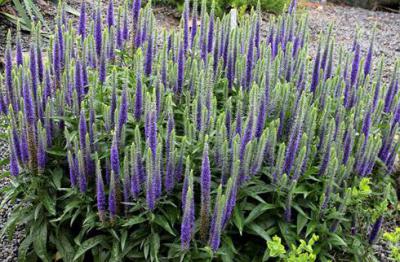

It blooms with a dense brush, which is narrowed towards the top. Its length can be from 5 to 30 cm. Small flowers are kept on short, shaggy pedicels. The calyx consists of four elongated lobes of different lengths. The most common flowers are blue or bright blue. But the corolla is purple, pink, or white.
After flowering, Veronica spicata forms rounded capsules with glandular hairs. Smooth, flat-convex ovoid seeds ripen in them. Their length is 0.75 mm and their width is 0.5 mm.
Flowering begins after June 10 and lasts about 35 days.
Veronica Dubravnaya photo and description
Veronica oakravnaya Veronica chamaedrys L. is a perennial herb 10 - 40 cm high with a creeping rhizome and erect or erect stems. Bright blue flowers are collected in opposite few-flowered racemes in the axils of the upper pair of leaves. Blooms from late May to August.
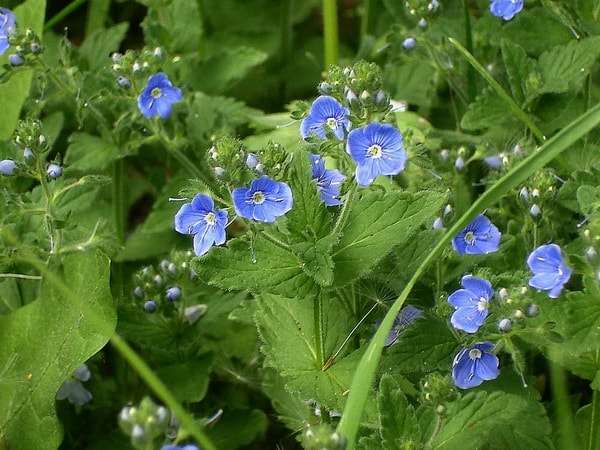

Veronica Dubravnaya grows on forest edges, glades, steppe slopes. The plant has adapted to the lack of moisture, it waters itself, using all the moisture that falls on it. The leaves of the plant are opposite opposite, the hairs on the stem are arranged so that water, falling on the leaf, runs along the hairs towards the root.
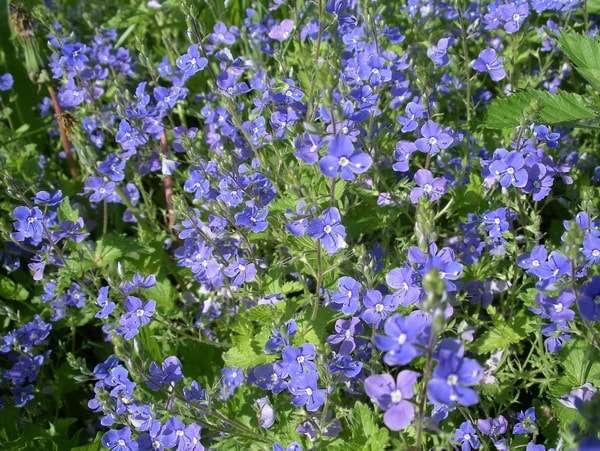

If under other plants, even after a heavy downpour, it is sometimes dry, then under Veronica Dubravna, even after any light rain, it is always wet and humid.
The specific name of Veronica oak chamaedrys comes from the Greek words chamai - low and drys - oak, named after the main habitats of the plant.
Decorative qualities
Veronica is a flower that was used in culture as early as 1570. Today she is a good decoration in mixborders. But often it is planted as a single flower.
Veronica also looks good in rocky gardens and near hills. The flower will bloom luxuriantly if it is allocated a sunny area. If you want to combine with other plants, then it is in harmony with carnations, saxifrage, Dalmatian geranium, stonecrop.
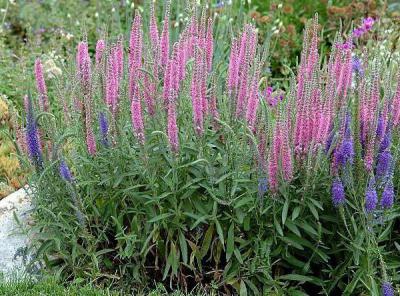

Growing a flower
Often, Veronica Dubravnaya is bred in front gardens and garden plots. The cultivation process is quite simple, since the plant is unpretentious and takes root quickly. The method of dividing is used for planting, but the flower can also grow from seeds. Growth requires access to sunlight and moderately fertile land. When planting Veronica, you need to remember that she does not tolerate damp and heavy soil.Planting can be done in autumn or spring. After the flowering has passed, the dried branches are cut off. The plant is not covered for the winter.
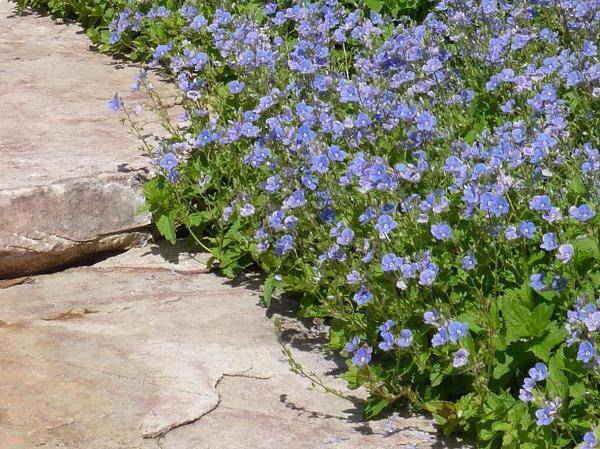

Veronica spiky: planting and caring for the plant
You can plant this flower on your site using cuttings or by dividing the bush. Also, the plant grows well from seeds. It is worth noting that the flower can self-seed. In open ground, seeds are sown in early autumn, when the ground temperature is about 15 0 C to a depth of 0.5 cm. There are sprouts already in the second week. In order for the plant to emerge and take root, it needs a light soil of medium moisture. But many gardeners note that Veronica is not so demanding of the land in which it grows.
A plant grown from seed can be transplanted to its permanent place the next year in late summer or early September. It's good if it is a sunny area or partial shade. It is recommended to maintain a distance of 30 - 50 cm between each seedling. Spikelet veronica blooms in the second year after sowing. An overgrown bush can be divided.
The plant does not need winter shelter, since it calmly tolerates the frosts of central Russia. Also, Veronica is drought-resistant, although if rainy days are given, she tolerates this too. In spring, the flower is watered only if it is dry outside. It is good if you carry out a little mulching near the bushes. Veronica is spiky, varieties above 60 cm need to be tied to a support.
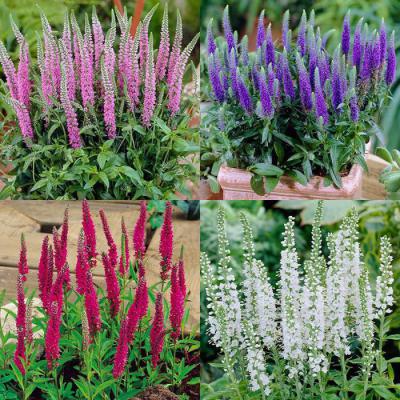

The plant can die from severe waterlogging in winter.
The most famous varieties
Of the huge number of popular types of flowers, the following plants can be distinguished:
Medicinal
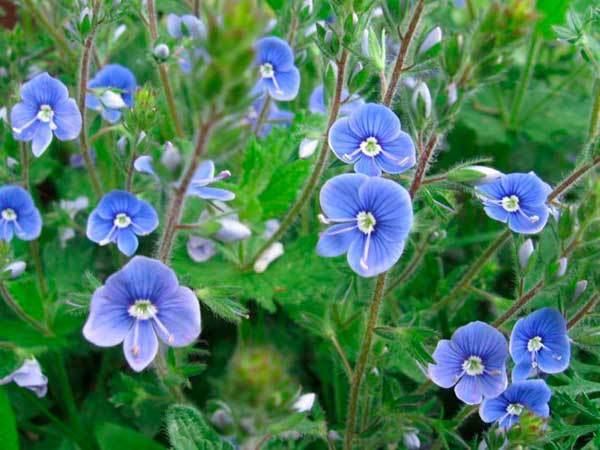

Veronica Medicinal
It grows in a wooded area. Distinctive features are undersized stems creeping in a carpet... On them are pale green leaves and lilac inflorescences.
Branched
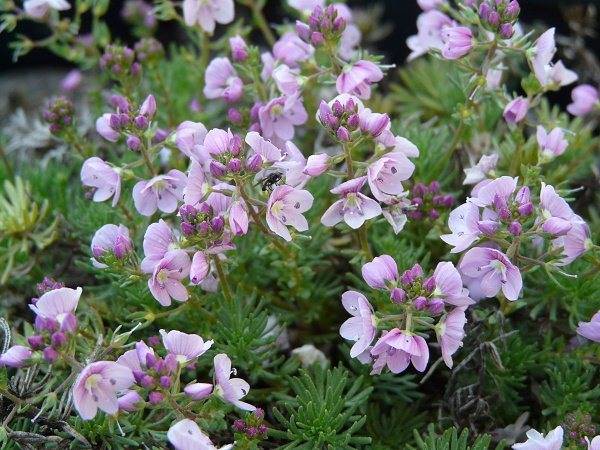

Veronica Branched
The main habitat is mountainous terrain. Looks like low thickets, covered with inflorescences of blue and pink shades... This variety is demanding to care. It is difficult to endure drought, in winter it can freeze.
Dubravnaya
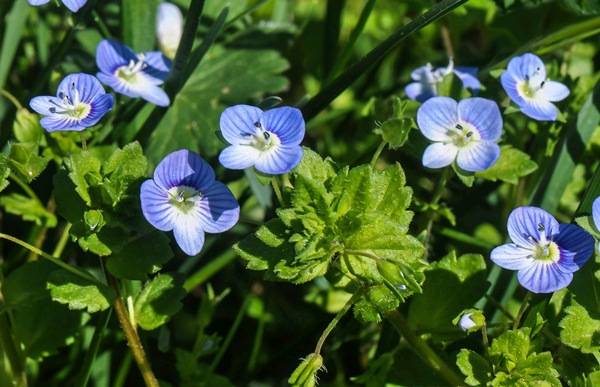

Veronica Dubravnaya
Found in Siberia, the Caucasus Mountains, in European countries. Perennial plant of low growth, forms jagged leaves that remain green in the winter season... Veronica oak tree blooms in blue, blue and even pink shades.
Small
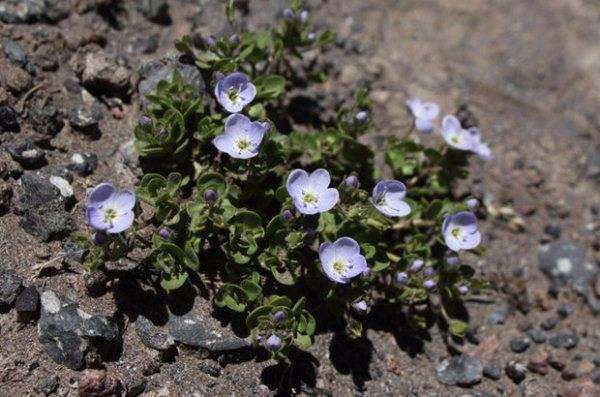

Veronica Melkaya
The view is very peculiar. Its distinctive features are short stature, small leaves, inflorescences of lilac and blue shades... This variety is quite whimsical, only experienced gardeners are engaged in its cultivation;
Woody
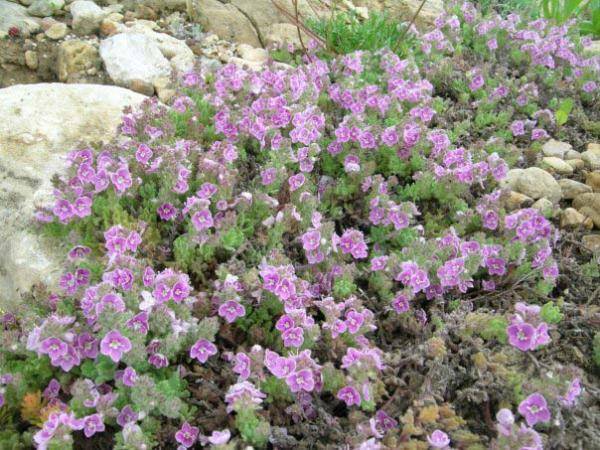

Veronica Woody
Perennial of low growth. Forms creeping stems covered with abundant foliage... In winter, it can freeze without snow cover.
Use in traditional medicine
Veronica spicata is not only a beautiful decorative flower. It has medicinal properties and is popularly used for colds, tuberculosis, bronchitis, liver, kidney, stomach and bladder diseases. Also, this plant relieves rheumatism, menopause, if there are internal bleeding, neurosis, insomnia or severe fatigue. Some people use this variety of Veronica for rashes and eczema.
Related article: Crimean hawthorn - useful properties, description
This herb helps during the listed ailments, since it has anti-inflammatory, wound healing and hemostatic effects. To some extent, spikelet Veronica has antibacterial properties.
Medicinal properties and application
The characteristics of the medicinal properties of medicinal Veronica are quite diverse. It acts as a hemostatic and analgesic, has an antiseptic and wound healing effect.When used internally, agents from this plant act as expectorant, diaphoretic, mucolytic, i.e. thinning mucus in the respiratory organs. The healing use of Veronica increases appetite and stimulates the secretion of various glands.
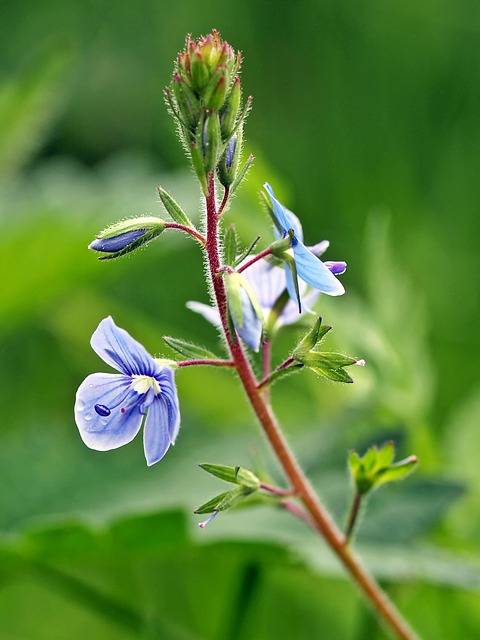

This medicinal plant is used in accordance with its medicinal properties. Preparations from it are used in the treatment of bronchial asthma, colds, bronchitis and sore throat, as well as tuberculosis. Veronica has a good effect on inflammatory processes in the gastrointestinal system. In folk medicine, it is used for diarrhea, gastritis with low acidity of gastric juice, for urolithiasis, and other diseases of the kidneys and bladder. This remedy is used for diseases of the liver, gallbladder and other indications.
Preparations from Veronica officinalis have a positive effect on the nervous system. They are used for nervous exhaustion and insomnia. Drugs help with diseases of the joints: gout and rheumatism.
In some cases, the preparations of their Veronica are used for external use. It helps with skin diseases, both chronic and temporary, such as sunburn.
Harvested plant during flowering. Collect the entire aerial part, without roots. Dried outdoors, but not in the sun, or in rooms with good ventilation. Properly dried grass has a pleasant smell, while fresh grass has no smell.
No contraindications found.
Recipes
With purulent wounds, a gruel is made from fresh leaves and applied to sore spots.
- An infusion is prepared for internal use. To do this, take two teaspoons of dry crushed herbs and brew with two glasses of boiling water. Insist for two hours, then filter. Take half a tablespoon one hour after eating.
Collection and procurement of raw materials
For the purpose of healing, only the aerial part of the plant is used. You can start harvesting raw materials in July, the collection lasts until September. The plant must be cut with sharpened scissors or a sickle. Before drying, the harvested material is sorted out. It is necessary to separate the yellowed parts and damaged stems. Fresh grass is spread on a spacious area in a thin layer so that drying is uniform for both the lower and upper stems.
To prevent decay, plants and fungus appear, it is recommended to turn the raw material every day. Well-dried grass is folded in fabric or paper bags without tamping. The medicinal plant retains its properties for 24 months, after which it loses its value.
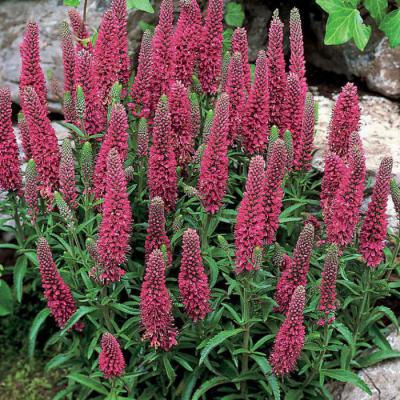

Veronica medicinal useful properties and contraindications
Veronica officinalis L.
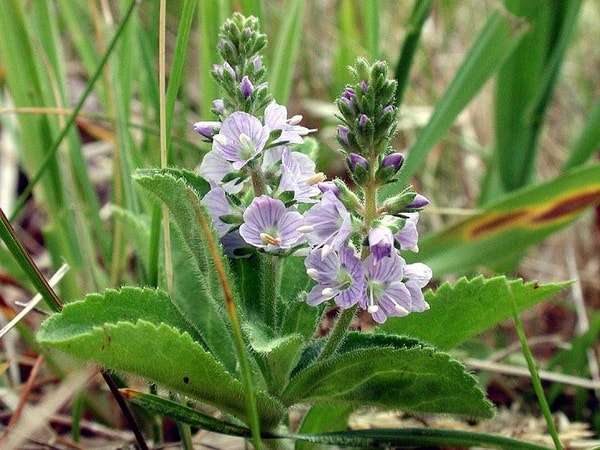

Veronica officinalis herb is used in acute and chronic diseases of the upper respiratory tract, diseases of the gastrointestinal tract, liver and bladder, headache and joint pain, with internal and external bleeding, chronic skin diseases.
The content of the article
Veronica Veronica is a genus of plants of the Plantaginaceae family Plantaginaceae, earlier the genus belonged to the Norichkovye family. These are usually grasses, sometimes shrubs, more than 300 species of Veronica are known, common in the Northern Hemisphere in temperate and cold areas, in the highlands.
The scientific name of the genus Veronica comes from the Greek words: vera - true, real and Nike - Nike, the goddess who personifies victory, which emphasizes the exceptional healing properties of the plant.
Veronica officinalis herb photo
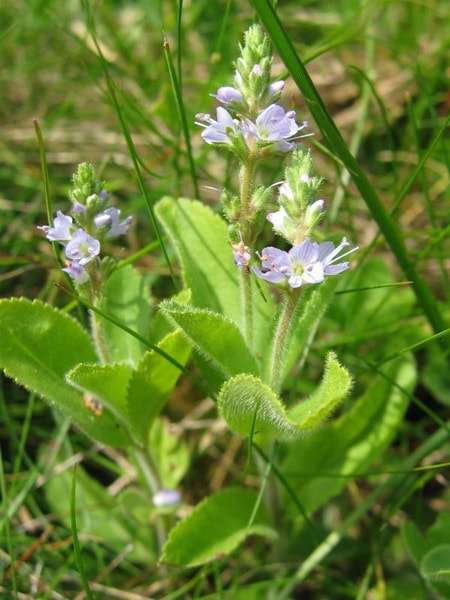

Description Veronica officinalis, Veronica officinalis is a perennial herb 15 - 30 (up to 50) cm high with creeping, rooting, pubescent shoots that go up.Leaves of Veronica officinalis are opposite, oblong, pubescent on both sides, 1.5 - 4 cm long, 1 - 2 cm wide, narrowed at the base into short wide petioles.
Flowers, lavender or bluish, sometimes white, with a four-part calyx and a four-petalled corolla, collected in inflorescences - clusters in the axils of the upper leaves at the tops of the stems. Blooms from June to September. Fruits are flattened polyspermous bolls, ripen from July to October. Propagated by seeds and vegetatively.
Veronica officinalis is distributed throughout the European part of Russia, in the Crimea, in the Caucasus. It grows in glades, meadows, forest edges, in light forests, forest ravines, in the mountains up to the subalpine belt. In open places, edges, clearings, it forms a continuous carpet of intertwined stems.
For medicinal purposes, the herb of Veronica officinalis is used - aerial shoots. They are carefully cut so as not to damage the root, with leaves and flowers at the beginning of flowering. Dried at a temperature of 35 - 40 ° C, paying attention to the flowers not to change color or crumble. The dried raw material has a pleasant weak odor and a tart bitter taste, shelf life is 2 years.
Veronica medicinal useful properties are due to the rich chemical composition of the plant.
The herb contains glycosides 0.5 - 1.2% - catallol, aucubin, veronicoside, minecoside and others, sterols, saponins, essential and fatty oils, bitterness, tannins about 0.6%, flavonoids - apigenin, luteolin, cynaroside, nitrogen-containing compounds, choline, coumarins, organic acids - lactic, tartaric, acetic, citric, malic, phenol carboxylic acids and their derivatives, carotene, vitamin C.
Veronica's application
On the basis of this plant, you can prepare useful decoctions and infusions. Here are some recipes:
- Take this infusion ½ cup three times a day. For cooking, you will need two tablespoons of crushed dry raw materials. Add two glasses of steep var (400 ml) and wait two hours. The medicine is ready.
- To make a broth in an enamel bowl, pour a glass of boiling water and put the herb (20 g). This medicine comes in a water bath for 15 minutes. The already cooled drink is filtered. But this tool can be applied not only internally. If there are rashes, itching and other skin problems, baths or rinsing are done.
Medicinal herbs can really help, but before starting your own herbal medicine it is better to consult your family doctor.
Napar, tea drink and much more
Medicinal Veronica is brewed (2 tablespoons) in boiled water. You should drink this mixture all day if you have scrofula, gout, eczema, rheumatism, or skin conditions. The vapor from this herb is great for removing fluid from the body if you have sand in your kidneys or bladder. It is also a good remedy for coughing up and thinning phlegm in case of bronchitis and other diseases. Veronica's juice. The plant is filled with alcohol in a ratio of 1: 4 and applied internally and externally. Baths from Veronica. Baths are made from this herb for babies if they have skin diaper rash, dermatitis and scrofula. Tincture. 1 glass of fresh medicinal Veronica juice is mixed with 1 glass of ninety-degree alcohol. Remains for ten days. Now we filter the infusion, pour another glass of alcohol into it, filter it through cotton wool, put a little Peruvian balm into the filtrate. Before using the tincture as directed, shake it. Use it for skin diseases. If you pour 500 grams of boiling water into it, you can use this mixture for washing with bruises, itching, wounds, cuts. In places infected with fungi, rub the infusion with a cotton swab.
Veronica officinalis
A brief description of. Veronica officinalis - Veronica officinalis L.- a perennial herb from the family of norichnikovykh with creeping rooting shoots up to 50 cm long. In Russia, it occurs in almost all regions of the European part and in the Caucasus, where it rises to the subalpine belt. The main habitats of this plant are coniferous forests, in addition, it grows in meadows, glades, forest edges, clearings, in forest ravines.
Medicinal value. Veronica officinalis is used only in traditional medicine. For treatment, aerial grass is used. It contains carotene (provitamin A), ascorbic acid (vitamin C), bitterness, glycosides, essential oil, tannins.
Due to its antimicrobial, fungicidal (inhibiting the growth and division of fungi), hemostatic and wound-healing properties, Veronica herb is widely used for the external treatment of wounds and skin diseases. With festering wounds and ulcers, acne and purulent, itchy rashes, as well as with fungal skin lesions, with sweating of the legs, baths, rinsing, compresses, lotions are made from the herb infusion. Well-crushed leaves are applied to purulent wounds and ulcers.
Veronica is used in homeopathy as a good choleretic agent, included in breast tea. This is the oldest folk remedy. The use of Veronica officinalis used to be very wide. It was used for diseases of the liver, kidneys, spleen, for female diseases, for tuberculosis, diabetes, and cancer. Now the plant is used mainly for colds of the respiratory tract and bronchial asthma. The plant is characterized by anticonvulsant, analgesic, anti-inflammatory, expectorant effects.
Usually an infusion is made from Veronica herb. The content of bitterness and tannins allows the use of Veronica officinalis to stimulate appetite and improve digestion. Veronica medicinal, according to the assurances of some traditional healers, has a calming effect, which explains the prescription of drugs from her with increased nervous excitability (especially with menopause), insomnia, headaches. It is also prescribed as a hemostatic for various internal and external bleeding.
Snake and poisonous spider bites can be relieved by steaming dry or fresh grass, tying it to a wound, and drinking a decoction from it.
Traditional medicine recipes.
For gastrointestinal diseases accompanied by diarrhea, gastritis with low acidity: 2 tbsp. spoons of herbs are poured into a thermos with 2 cups of boiling water, insisted, drunk in 3-4 doses 20 minutes before meals.
In the treatment of intestinal disorders: 1 teaspoon with the top of the grass is poured with 1 glass of boiling water and insisted for half a minute. Strain and drink at least 1 glass a day. Hot infusion works best.
For diseases of the urinary tract and gout: 2 teaspoons of herbs in 2 cups of boiling water, insist, wrapped, 2 hours, drain. Take for gout, salt deposition 1/2 cup 4 times a day one hour after meals.
rus-
Veronica long-leaved: description, medicinal properties, use in medicine
Veronica longifolia is a perennial plant. The plantain family, to which this herb belongs, prefers to grow on wet meadows and river banks. People also call it snake grass and gourd.
Veronica long-leaved is found throughout Russia. It only smells when dry. The smell of this plant is very pleasant, but it tastes bitter. This herb has medicinal properties. Some healers are sure that she is able to help even in severe cases.
Variety of names
Given such a wide distribution, Veronica Dubravnaya in different parts of the country can be called differently. Here are some of its names: wild forget-me-not, hearty grass, cog, oak tree, consumable, sheep grass, hernia grass, cichon, eyebright, anpirka, konotopets.The variety of her names does not end there, but in botanical encyclopedias this plant is called Veronica chamaedrys.
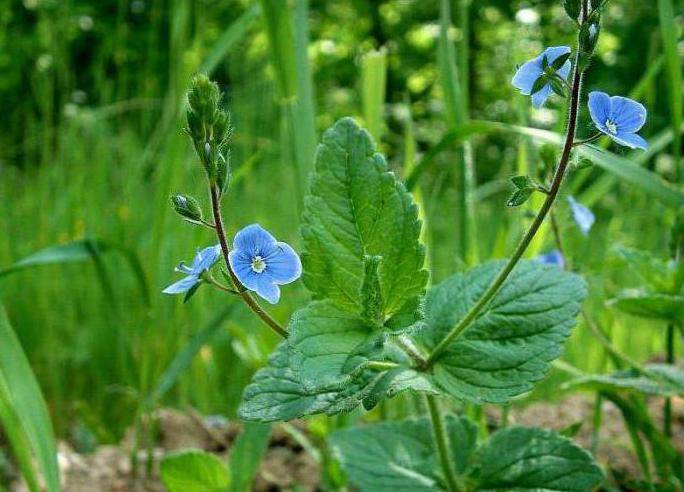

Veronica long-leaved: description
This perennial plant has a long creeping rhizome. Its stem is pubescent, erect, branched or single. It can reach a height of up to one and a half meters. The leaves of the serpentine grass are opposite, short-petiolate, with a finely serrated edge.
The plantain family, to which the herb belongs, has long been used in alternative medicine. The gourd blooms all summer. Its small blue flowers are collected in long clusters that are located on the top of the stem. The fruits of this herb are small two-nested capsules that ripen in early autumn.
There are other varieties of this plant. For example, Veronica is long-leaved pink, reaching a height of 0.8 meters. It differs from other plants in its pale pink inflorescences that appear in the middle of summer.
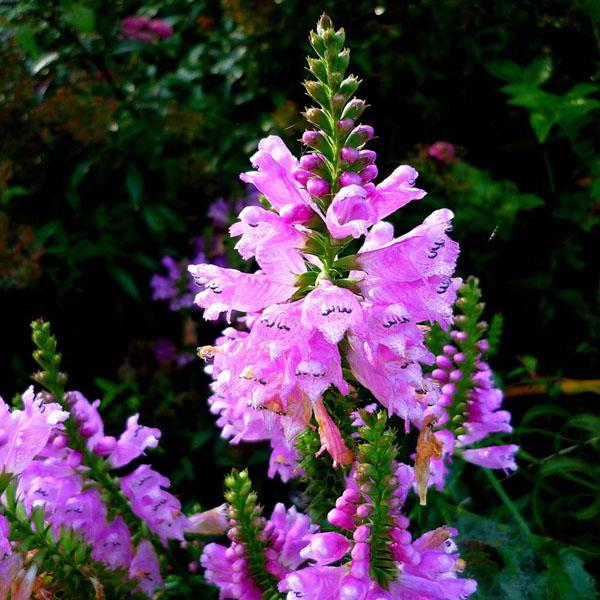

Reproduction of Veronica
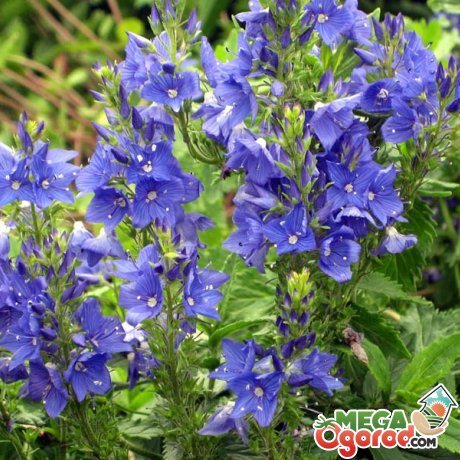

The easiest way to propagate Veronica is by dividing the bush:
- This is done during the period when the plant is not blooming. But you can also plant it in the summer.
- To do this, they dig up the plant, divide it with a shovel and plant it. If the weather at this time is dry and hot, then you can cut off the flowering part.
- Then cover the transplanted plants with jars or cut plastic bottles with the cap removed. Use such a mini-greenhouse for up to a week and a half.
- Delenki root well in peat and sand.
- Planted at a distance of half a meter for large species, 40 cm for medium and 30 cm for small species.
Cutting Veronica:
- For propagation by cuttings, they are harvested in the middle of summer. Length 10 cm.
- Cut off the top and inflorescences.
- Rooted in a mixture of peat and sand.
Veronica can be propagated by seeds. They are found in a two-celled capsule (sometimes in a single-celled one). Veronica differs from other genera of the Plantain family by a large variety of fruit forms. The seeds are relatively small. There are usually no more than three of them in a box. Sow the seeds of Veronica before winter. Then germination will be better. In order to sow in spring, the seeds must be stratified for at least a month at a temperature of 5 ° C.
There are types of Veronica, which do not need to be propagated - these are weeds: Veronica plowed, field, ivy, modest, Persian.
They reproduce themselves. The filamentous Veronica is especially active in reproduction. She can grow even small parts that were formed when mowing the lawn.
What are the beneficial substances in snake grass?
Veronica longifolia is widely used in folk medicine. And all thanks to a large number of healing properties and a unique composition. The plant consists of the following components:
- alkaloids;
- glycosides;
- essential oils;
- tannins;
- fatty oils and flavonoids;
- carotene;
- ascorbic acid;
- organic acids, including malic, acetic, citric and tartaric;
- phenolcarboxylic acids.
Veronica long-leaved, whose medicinal properties have long been known to folk healers, has an anticonvulsant, tonic, tonic, antimicrobial, anti-inflammatory, expectorant, diaphoretic, hemostatic, diuretic and anti-allergic effect on the body. In addition, it has an immunostimulating, analgesic, anthelmintic and choleretic effect.
Means based on this herb are used to treat various diseases and pathological processes. They effectively fight sweating, bruises, migraines, fatigue, boils, dry coughs, pneumonia, asthma and colds. Snake grass preparations help:
- Remove the inflammatory process.
- Accelerate wound healing.
- Boost immunity.
- Improve metabolism.
- Eliminate spasms, cramps and pain.
- Normalize carbohydrate metabolism and stomach function.
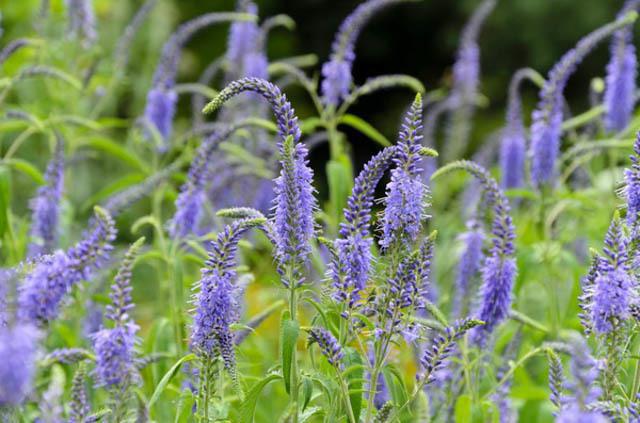

Veronica medicinal, Veronica Dubravnaya. Collection and application
Veronica's herbs are spring-summer honey plants, from 1 hectare they receive up to 18 kg of healing fragrant honey.
Hello dear reader!
Veronica Dubravnaya is a rather modest grass. The flowers are beautiful, but smallish - about five millimeters. Growth can reach two to three tens of centimeters, but usually less. And the plant has healing properties, but Veronica did not acquire loud fame.
She is not spoiled by fame at all. Most of us have seen Veronica Dubravnaya. It grows in deciduous and mixed forests in most of the forest zone of Russia. And in shrub thickets, and on the borders of fields, and in meadows.
But not everyone knows the name of a small grass that blooms with light blue flowers in the second half of June. Sometimes even "forget-me-not" is called, although the similarity of forget-me-not and Veronica Dubravna is only in the color of the petals. And this is not enough.
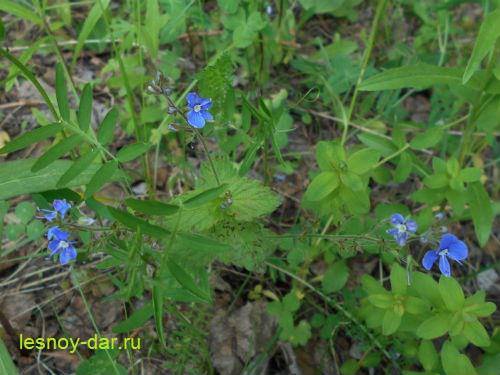

I have come across other names only in literature. Perhaps some of the readers know other local names for the herb - please unsubscribe in the comments. It seems to be sometimes called "pansies". The flowers of Veronica Dubravnaya are definitely similar to someone's eyes. But of course, there is nothing in common with the tricolor violet.
The name of the genus Veronica was given in the 16th century by the German botanist Leonart Fuchs, seemingly in honor of Saint Veronica. There is a certain meaning, the day of St. Veronica in the Catholic "calendar" - July 12. The very height of flowering of different species of this genus.
Veronica Dubravnaya - description and photo
Consider Veronica Dubravnaya in more detail. It is a rhizome perennial. Stems are erect or lodging, slightly pubescent. Small oval or ovoid leaves are opposite, in pairs. The lower leaves on short petioles, growing higher, are sessile. The edge of the leaf is serrated or crenate. Leaves are slightly pubescent.
At the top of the shoot, the leaves grow so close that they form a kind of "false whorl". Slightly below, from the axils of the stem leaves, one or two peduncles grow, bearing scattered flower brushes.
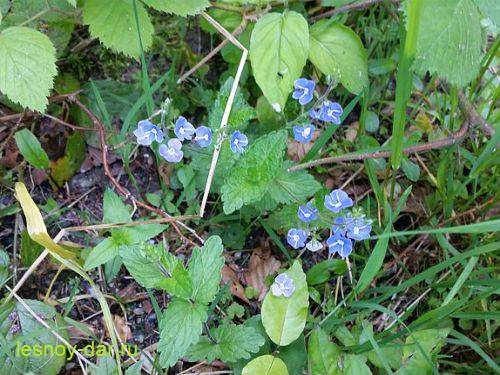

Previously, Veronica was attributed to the Norichnikov family, now it is counted in the Plantain family - mainly according to the structure of the flower. Flowers are four-membered and irregular. And these are their main differences from the correct five-membered forget-me-not flowers (for those who are confused).
The corolla has four petals. Three of them are similar to each other, the fourth differs both in shape and size. The color of the petals is blue or light blue, often with white edging. There is a white-yellow spot at the base of each petal. They merge into a ring surrounding the stamens and pistil. Purple stripes are clearly visible on the petals.
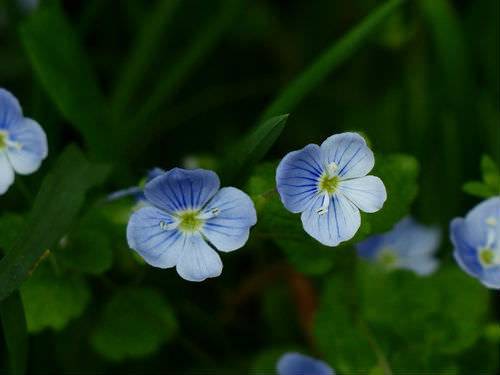

The calyx is fused, represented by four green teeth, half the length of the petals. There are two stamens, they often resemble the hands on a miniature watch. One pestle.
The use of veronica dubravnaya in folk medicine
For medicinal purposes, another species is more often used, called Veronica officinalis. But the properties of plants are similar. Traditional medicine also uses Veronica Dubravnaya, and other types - for example, Veronica long-leaved.
VP Makhlayuk, in his excellent book "Medicinal Plants in Traditional Medicine", devotes only one small article to the description of the use of all types of Veronica. My task is somewhat different, so I hope to "please" readers with several posts about different species of this genus.
Collect the herb of Veronica during the flowering period. Dried in the usual way - under a canopy in the shade, spread out in a thin layer.
Infusion of Veronica herb has anti-inflammatory and expectorant effects, stops bleeding. It is used for broncho-pulmonary diseases (up to pulmonary tuberculosis!), For inflammatory processes in the gastrointestinal tract. Outwardly - as a hemostatic and wound-healing agent.
Undoubtedly, the antimicrobial and fungicidal (antifungal) properties of Veronica herb help to heal skin diseases - various fungal lesions, abscesses, acne, and rashes.
Prepare the infusion by pouring 2 teaspoons of dry Veronica herb with 2 cups of boiling water. After a two-hour infusion, the infusion is filtered. Drink half a glass 3-4 times a day after meals.
Veronica Dubravnaya is not the only widespread plant of the genus. I will introduce some of its interesting representatives in other blog articles. For those who have not yet subscribed to the news, I advise you to do it right now.
Best regards, Alexander Silivanov
lesnoy-
How is Veronica longifolia applied?
Wild plants are often used by healers. Basically, the rhizome and the aerial part of the plant are used for medicinal purposes. In the first case, the harvesting of raw materials is carried out in September, and in the second - during flowering (July-August).
Snake grass is considered an excellent antiseptic. Its aerial part is used for the preparation of medicinal decoctions and infusions, which are used to eliminate hemorrhoids, uterine bleeding, headaches, liver diseases, coughs, pulmonary tuberculosis and digestive disorders. They also wash wounds with similar means and even lubricate snake bites.
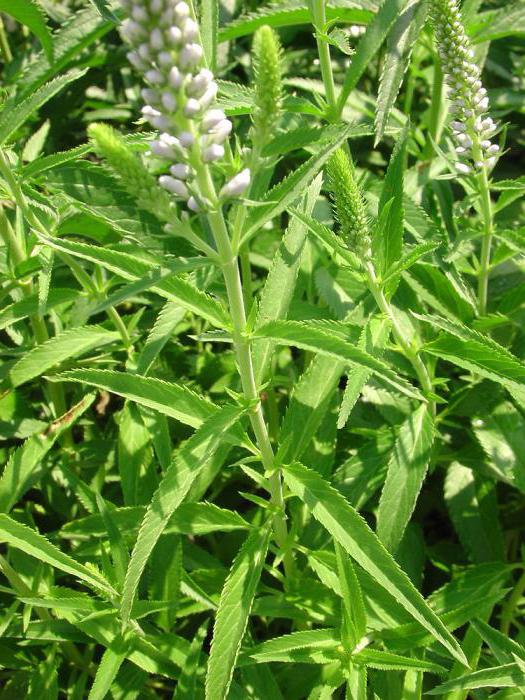

We collect veronica and dry
The herb is often used medicinally. The collection of Veronica is carried out at the time when it blooms. The stem of the plant is cut off at the very base. This is done to prevent the plant from pulling off the roots. What is the effect of medicinal veronica
Veronica was previously used in classical medicine. Now it is used less frequently, most often for the treatment of bronchial asthma and respiratory tract. To this end, you need to brew the top of the plant, insist, drink what we got. Traditional medicine uses this type of Veronica to relieve pain, restore blood, heal wounds, and get rid of phlegm. Also, when the appetite is low, the intestines are upset, there are liver diseases, furunculosis, sleep disorders, menopause, rheumatism, skin diseases. If you have diabetes, cancer, tuberculosis, you can also use the infusion of Veronica. In European countries, this type of Veronica - medicinal is often put in a mixture for tea. There are no contraindications to the use of infusions from this plant.
Recipes for the preparation of medicinal infusions
Veronica long-leaved is quite often used to eliminate cracks in the heels and fungus on the feet. For disinfection and treatment of feet, it is necessary to use an alcoholic tincture from this herb.
To get a high-quality product, you need to pour about 10 tablespoons of a dry plant with vodka, 0.5 liters will be enough. The resulting mixture is removed for infusion in a dark place for at least 2 weeks. With this medicine, wipe the affected areas several times a day, the applied liquid should be completely absorbed into the skin, after which you can put on socks. The duration of therapy is about 10 days.
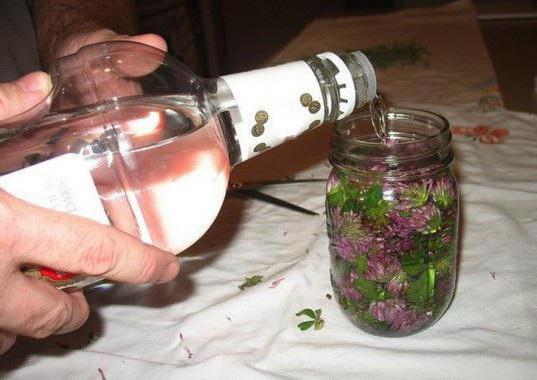

Veronica longifolia helps to relieve burns and purulent wounds. To prepare the product, you will need 15 tablespoons of snake grass and 1 liter of vegetable oil, preferably olive or corn oil. These ingredients are well mixed, after which the mixture is kept in a dark place for a week. After 7 days, the affected skin is lubricated with such a medicinal solution. Another similar remedy is suitable for the treatment of dermatitis and eczema.
For mental disorders, headaches and improving well-being after childbirth, it is recommended to take an infusion made from 10 g of dry roots of a gourd and 200 ml of water. The mixture should first be boiled for 6 minutes and then left to rest for an hour. After that, filter the drink and drink 1-2 tablespoons in the morning and evening.
Snake herb is also often used in the fight against arthritis. The collection of medicinal plants brings an excellent effect in therapy.For the preparation of the drug, 3 parts of the roots of wheatgrass, burdock, violet and veronica herb, as well as 2 parts of a series are used. Approximately 25 g of the collection is poured with a liter of water and cooked over low heat for 15 minutes. When the medicine is infused, it is consumed 200 ml 3 times a day on an empty stomach.
Veronica longifolia is also used to treat pyelonephritis. In this case, juice from this plant is used, which is mixed with goat's milk. The resulting mixture should be drunk in the morning (30 minutes before breakfast).
But for asthma, it is useful to combine snake grass with sweet clover, nettle, plantain, coltsfoot. This collection is best added to tea. You can also gargle with this broth in case of exacerbation of laryngitis, tonsillitis or tonsillitis. To speed up your recovery, you need to rinse for 3 minutes (at least 6 times during the day).
Also, pectoral grass is used to treat kidney damage and gout. It is most effective to use Veronica longifolia juice or extract for such purposes. It is necessary to consume a healing drink on an empty stomach, 40 ml several times a day. Sometimes it is enough to drink it for 3 months for the disease to recede.
All about medicinal plants
Veronica spicata most often has a strong, straight, single stem. Basal leaves are opposite, oblong, with a wedge-shaped base, on small petioles. The leaf blade is crenate along the edge, or weakly serrate up to about half of the leaf. The upper leaves are alternate, sessile, sometimes slightly serrate. The inflorescence is solitary, paniculate, located at the apex of the stem. The flowers are purple. It grows mainly in sparse forests. Prefers dry, sandy soils.
The medicinal raw material of both types is the aboveground part, harvested during flowering. Dried in the shade in the usual way. By its properties, Veronica long-leaved (spicate) is similar to Veronica officinalis and will be described in the corresponding section.
Veronica key (coastal) is a perennial herb of the plantain family (norichnikovye). Plants up to 80 cm high. The rhizome is thick, creeping with many fibrous adventitious roots, the stem is juicy, straight, indistinctly tetrahedral, hollow inside, simple. Leaves are opposite, sessile, oblong or lanceolate along the edge serrate-toothed with one, less often with three veins. The flower-bearing racemes of Veronica Key are located in the axils of the upper leaves. The flowers are small, pale blue. Blooms all summer. The fruit is a capsule.
On the territory of Russia and Ukraine, it is found everywhere. It grows along river banks, in shallow waters, in damp meadows, where there is a lot of moisture and light.
Blank. Beneficial features.
The aboveground part of the plant, harvested during flowering, is used as a medicinal raw material. It is used both fresh and dry. Dried in the shade or in an active way. It is used only in traditional medicine. Veronica key preparations have hemostatic, wound healing, antitumor properties. Promotes the elimination of toxins from the body, lowers blood pressure, and normalizes cardiac activity. Fresh leaves are eaten in the form of salads.
Recipes.
For the preparation of the broth 3 tbsp. Pour tablespoons of dry herbs with two glasses of boiling water, cook for 5-10 minutes, strain after cooling. Take 1/3 cup 3 times daily before meals.
For the preparation of infusion 1 tbsp. pour a spoonful of herbs with a glass of boiling water, leave for two hours and strain. Take two tbsp. spoons three times daily before meals.
Veronica Dubravnaya is a perennial herb of the plantain family (norichnikovye). The rhizome is thin, creeping. Stem ascending, simple, sometimes branched, sparsely hairy, 10-40 cm high. Leaves are small, opposite sessile, rounded ovoid, crenate or toothed along the edge, pubescent.The flowers are irregular, small, bright blue, collected in rare, opposite, racemose inflorescences from 2 to 20 cm long. Fruit-box. Blooms from May to August. Propagated by seeds and vegetatively.
In Russia and Ukraine, Veronica Dubravnaya is widespread everywhere. Prefers open, sunny, dry areas. It is found in large numbers in meadows, forest glades, among shrubs, in personal plots, and quickly assimilates abandoned farmlands. It tolerates a lack of moisture well. Easy to cultivate. Veronica Dubravnaya is an excellent honey plant. The bribe from her is stable and long-lasting.
Aboveground part of plants is a medicinal raw material. Harvested during flowering. Dried in the shade in the usual way. The useful properties of Veronica Dubravna are the same as those of Veronica officinalis, so we do not dwell on them separately.
Veronica officinalis is a perennial herb of the plantain family (norichnikovye). The rhizome is long, creeping, with thin roots. The stem is recumbent, branched, rooting, with ascending flowering shoots. Leaves are simple, opposite, with short petioles, pubescent, serrate along the edge, completely marginal at the base. The flowers are irregular, pale lilac, collected in lateral flower-bearing racemes. The fruit is a capsule. Blooms from June to August.
Veronica officinalis is found everywhere in Russia and Ukraine. Grows in light, sparse forests, clearings, forest glades. It is less common in the fields.
Blank. Beneficial features.
For medicinal purposes, the aerial part of the plant, harvested during flowering, is used. Dried in the shade in the usual way. It is mainly used in traditional medicine.
Veronica officinalis (and its other varieties) has: analgesic, anti-inflammatory, expectorant, anticonvulsant, antiseptic, hemostatic, wound healing, antidote properties. Veronica's preparations are used for colds, bronchitis, asthma, sore throat, pulmonary tuberculosis, diabetes mellitus, insomnia, nervous exhaustion. Infusion of Veronica is recommended to be taken with the bites of vipers and rabid animals, as well as for the treatment of stomach ulcers, diseases of the liver, kidneys, and spleen. Veronica preparations are effective in the treatment of various skin diseases. They are not toxic. There are no contraindications for their use.
Recipes.
For the preparation of infusion 1 tbsp. pour a spoonful of dry chopped herbs with two glasses of boiling water, leave for one hour, strain. Take ½ cup 3-4 times daily before meals. For external use, a more concentrated infusion is made.
[The recipes presented on the site are for informational purposes only. Before using them, consult your doctor. This is not an advertisement.]
Snake grass in the fight against pneumonia
Treat pneumonia with a miraculous herbal infusion, which includes the following plants:
- veronica long-leaved;
- sage;
- heather;
- motherwort;
- hawthorn and rosehip berries;
- cyanosis;
- fennel;
- plantain;
- rhizomes of gravilata;
- clover, calendula and pine buds.
It is necessary to add 1 tablespoon of the collection to 200 ml of boiling water, mix and leave for 40 minutes. After the time has elapsed, the composition must be filtered. It is recommended to take the medicine 3 times daily for 60 days.
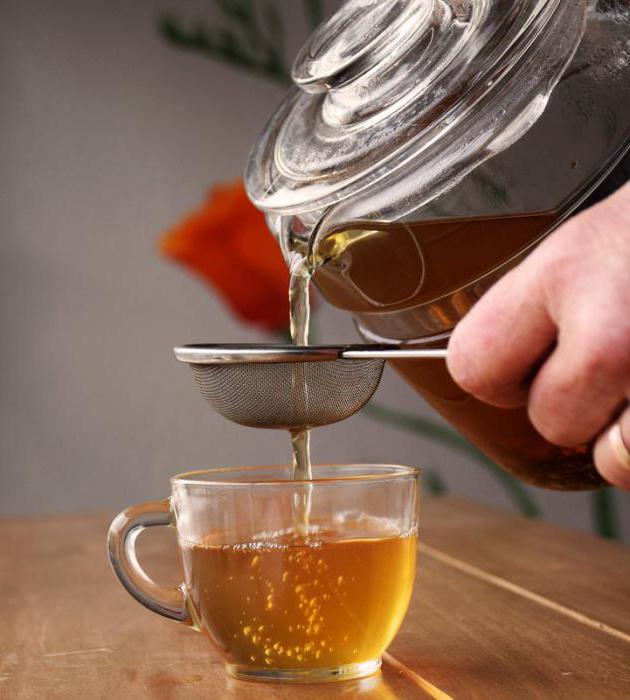

Veronica herb in the collection of medicinal plants
Veronica herb is a part of effective medicinal preparations and breast tea.
Veronica, like the succession, is one of the main agents used in the preparation of baths for babies with diaper rash of the skin, as well as baths for the treatment of scrofula and itchy dermatitis.
Herbal infusion with Veronica:
- Burmese herb - 1 part
- veronica's herb - 1
- violet tricolor herb - 1
Mix the chopped dry herbs, pour one teaspoon of the mixture with a glass of boiling water, leave for 30 minutes. Take 1 glass 3-4 times a day after meals. From this collection, you can prepare a bath infusion.
For acne, skin rashes, infusion of collection with Veronica:
- Budra ivy herb - 1 part
- veronica's herb - 1
One Art. l. pour the mixture with a glass of boiling water, boil for 10 minutes, leave for 2 hours. Use for washing and lotions.
For gout, collecting with Veronica:
- Burdock root - 3 parts
- wheatgrass rhizome - 2
- veronica's herb - 2
- violet grass - 3
Pour one tablespoon of the mixture with a glass of boiling water, boil for 10 minutes, leave for 30 minutes. Take 0.5 cups 4 - 5 times a day 30 - 40 minutes after meals for gout.
Contraindications:
- Individual intolerance
- Take with caution for acidic gastritis
- Take with caution in case of hypotension
When treating with medicinal herbs, for your health, it is always necessary to consult with your doctor.
Watch a short video:
Elimination of gynecological inflammatory pathologies
In the fight against women's problems, Veronica long-leaved is excellent. The use of this plant in medicine allows you to get rid of various ailments. Most often, a herbal collection of flowers of yellow melilot, chamomile, Veronica and Chernobyl is used.
A few tablespoons of dry raw materials are poured with a liter of hot water and kept for 35 minutes. A cleansing enema is made from the resulting warm mixture. Then, before going to bed, they drink 500 ml of hot broth and douche with the remaining solution. This procedure must be carried out at least 3 times a week for two months. When treating in this way, you will have to give up sex.
A decoction of Veronica also helps to eliminate the itching of the external genital organs in some gynecological diseases. This means they lubricate sore spots or make sitz baths.
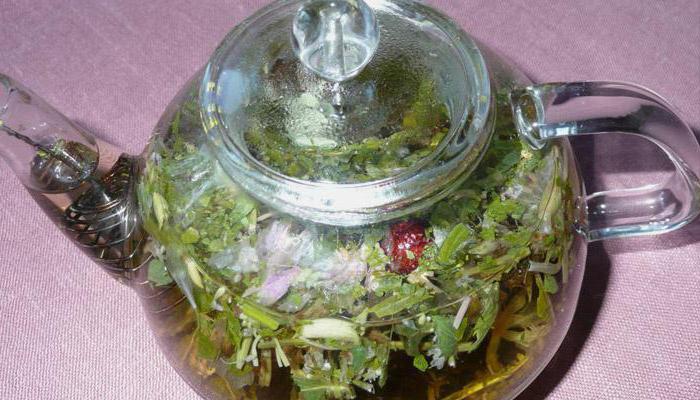

Useful qualities
The medicinal properties of the plant have been known since ancient times. Veronica has long been used as a cure for various diseases.
The tops of the stems with leaves and inflorescences are of particular value.... Harvesting is carried out with the onset of summer, when flowering is in full swing. Drying time must be reduced to a minimum, for which a temperature regime of forty degrees is created. This allows you to reduce losses and preserve the color shade If everything is done correctly, then Veronica will retain its healing properties for two years.
Besides, used as an ornamental plantto decorate the garden area.
Veronica is grown today on any type of soil composition. But the plant feels best on loamy soil. He needs a sufficient amount of light, although shaded areas are suitable for breeding.
Surely these small flowers of a piercing blue color are familiar to many: Veronica is a very common plant that is found on forest edges, in meadows, grows in roadside dust, and in the grass under trees and bushes.
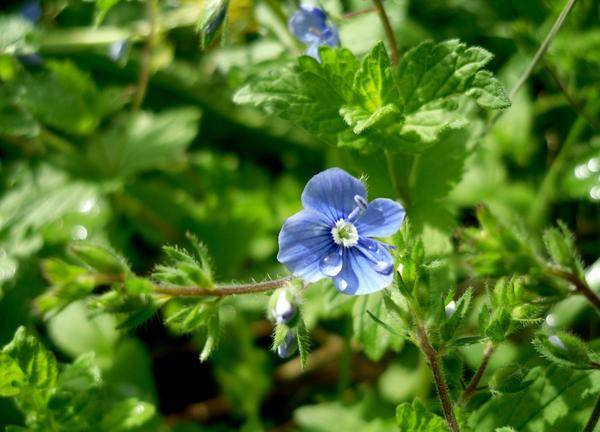

Various Veronica have long settled in the gardens: tall Veronica large and Veronica spikelet, ground cover Veronica threadlike and Veronica Armenian, and also Veronica officinalis and many, many others - and each with its own "zest". But it doesn't happen often to meet Veronica Dubravnaya in a flower garden. Meanwhile, its vast clumps are very elegant in color and very practical: covering the soil with its rapidly growing shoots, Veronica does not allow weeds to occupy the territory. It is appropriate in natural-style flower beds, in borders along garden paths, under garden shrubs and trees. This plant is undersized (usually 15 - 20 centimeters, rarely more), especially well combined with various decorative deciduous crops. And you can use Veronica for a natural lawn: it is quite resistant to trampling.
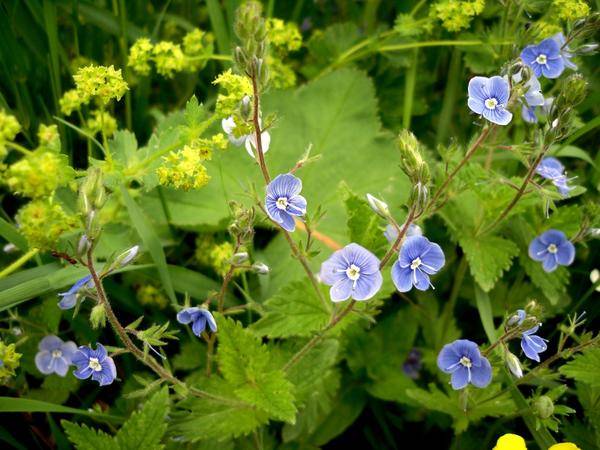

Veronica oakravnaya prefers neutral or slightly acidic soils.It is considered one of the indicators of acidity: if a lot of Veronica is found in the wild on your site, this may indicate that the level of acidity of the soil is increased, which means that when preparing the beds for vegetables, it will not be superfluous to add ash or to carry out liming in the fall. And even by the flowers of Veronica, you can predict the weather: on a sunny day, they are fully open, and close to bad weather, curl up.
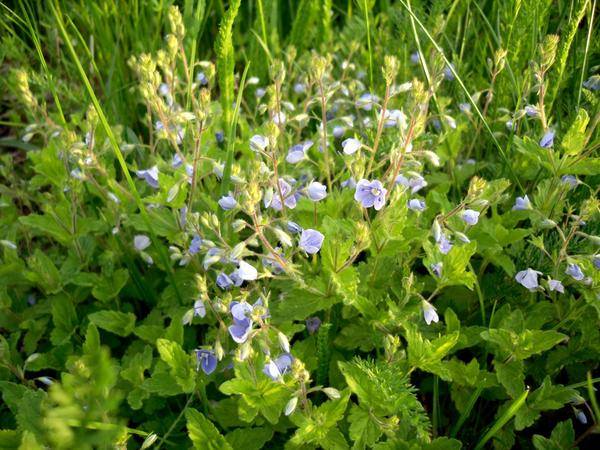

The healing properties of the herb of Veronica oakravna are also known. Grass is harvested at the time of its flowering (usually from mid-May to early July), dried and prepared decoctions and infusions. The preparations of Veronica Dubravnaya in folk medicine are used to treat diseases of the respiratory tract, as a choleretic and diuretic, and also externally for the healing of abscesses, ulcers, burns.
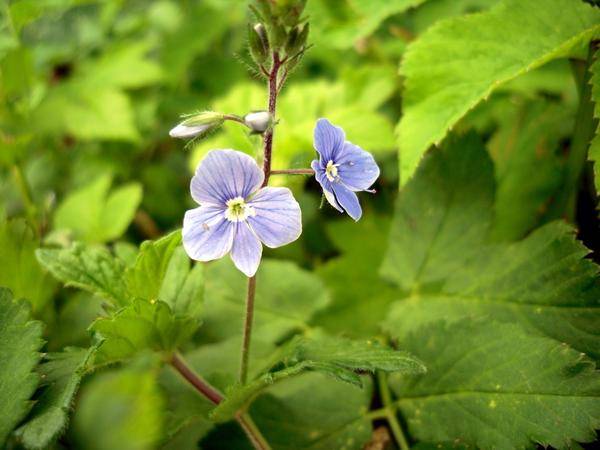

It is not difficult to transplant Veronica: its root system is shallow, superficial, and the plant takes root easily. In any case, I have never encountered difficulties in this matter. And every summer I admire the flowers of Veronica in my garden, I try to keep her wherever possible, so that the elegant blue flowers delight the eye for a longer time. Is your Veronica growing?
Diseases and pests of the veronica flower
Caring for Veronica includes preventive and curative measures aimed at eliminating pests. Here are the dangers that such a plant can face:
- An area that is too humid or too much shade can sometimes lead to downy mildew. It looks like a gray bloom on foliage. They fight this problem with a fungicidal solution using Fitosporin, Alirin-B, Gamair.
- Sometimes the crop is infected with the ring spot virus. You can get rid of it only together with an infected plant. Then the entire flower bed must be treated with nematicides. This virus is spread by nematodes that live in the ground.
- The plant can also be attacked by caterpillars. They feed on leaves and shoots, and in order to get rid of caterpillars, it is necessary to warm up the soil, weed it in time and take a short break in watering.
- If Veronica is attacked by moths, scoops or long-wattled moths, you can treat the flower bed with insecticides.
Distribution and ecology
Caucasus: Georgia (Trialeti Range), Armenia (Lake Sevan basin, Alagez Mountain, Leninakan Plateau); Asia: Turkey (eastern part to the Inner Taurus). Described from the vicinity of Erzurum
.
Grows on the rocky slopes of the alpine belt, at an altitude of 2000-3000 m above sea level
.
Veronica filamentous: plant features
Veronica filiform belongs to the Norichnikov family. It is a herbaceous plant with creeping shoots that take root in the ground almost instantly.
The plant is soil-rooted, low; spreads along the ground. The leaves are small, rounded, the flowers are white or blue-blue. The plant easily tolerates heat, grows in open sunny areas, but feels more comfortable in partial shade or in a completely shaded area.
This amazing type of plant is rightly labeled as a "terrible aggressor". When growing such a plant on the site, be prepared for the fact that it will spread throughout the yard in huge blooming spots, hide the unevenness of the landscape, and sprout between the tiles on the paths. So, to which group should this natural "decorator" be attributed: weeds or cultivated flower plants?
As in the wild, filamentous veronica prefers areas where trees (forest, fruit), berry bushes grow. She loves shade. This plant, actively growing, is ready to fill the entire yard, garden and beds with itself, but if you take proper care of it and do not give freedom to the reproduction of flowers, then this process is quite realistic to control.
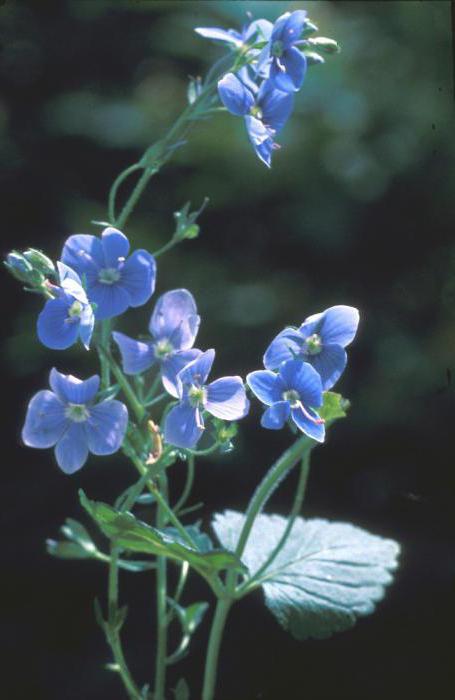

Agricultural technology is simple, because this fast-growing plant is so tenacious that it does not require the creation of special conditions for growing.But it is still worth getting to know the system of planting and caring for Veronica filiform.
The plant thrives on areas with moderately moist soil, but it tolerates drought well. That is why there is no need to create special conditions for the care of flowers. Veronica filamentous is a plant that takes care of itself, and it is capable of quite competitively competing against its neighbors. Even dandelions cannot stand the onslaught of an aggressive herbaceous plant.
Where is the best place to plant Veronica in the garden
Veronica is an excellent plant with high growing efficiency. Most of the Veronica varieties are very hardy and meet the requirements of our climatic zone.
Flowers love sunny locations with partial shade.
Therefore, for best results, plant them in a location where they will receive morning sun and daytime shade.
Veronica is tolerant of a wide range of soil types, but thrives in moist, well-drained and acidic soil that has been rich in compost or other organic matter at the time of planting.
The soil must be brought to a normal water balance. If the soil is dry, Veronica flowers tend to wither quickly. But if you resume watering, the plants can be quickly revived.
Did you know?
If you want to extend the flowering period of Veronica, there is an easy way to do it: remove several inflorescences growing together at once. Take extra care during processing to avoid removing excessive amounts of leaves.
Popular types of herb
Landscape designers have chosen some of the brightest varieties with the most beautiful flowers. They fit very harmoniously into a single style with, and large landscape varieties, such as molinia, etc. These popular varieties of Veronicastrum are:
Upright plant, up to 1.3 m in height. Blooms for more than 1 month. The shade of the inflorescence is creamy pink. Retains a captivating look during and after flowering. Both singly planted and planted in groups look impressive.
Did you know?
In different sources, Veronica is referred to either to the Norichnik family, or to the Plantain family. Botanical news for 2016 reports that Veronica and Veronicastrum have finally been assigned to the plantain family.
IN grade "Posea"
clear advantages are the height of plants up to 1.6-1.7 m, this is the tallest representative of the family, well, and a very delicate pink shade of flowers.
A short plant that blooms in a beautiful white color. The length of the inflorescence can reach up to 20 cm. It is popular among landscape planners for the design of accents in the general design solution. Attracts insects, especially butterflies. The plant is characterized by frost resistance and unpretentiousness to the soil. Variety "Alba"
Did you know?
The taxonomists have long wanted to define Veronica and Veronicastrum as a separate genus. They are united only by types and colors of inflorescences. And the most significant difference
—
height. Gentle Veronica does not correlate in any way with the giant Veronicastrum, which by the time of flowering can reach 2-2.5 meters in height.
In height grade "Fascination"
gains up to one and a half meters. But it differs in the lavender color of the inflorescence with a creamy pink tint. And also the reddish tint of the leaf plate, which looks especially attractive in plant design. But gardeners call the Siberian and Virginian Veronicastrum the most common varieties.
This type of plant grows up to 1.8 m. It has a strong stem without branches. Floor-by-floor arrangement of leaves. It blooms with spike-shaped inflorescences of blue color, which can reach up to 30 cm in length. Can be placed both in the sun and in the shade.
A distinctive feature of this type is that it is not susceptible to disease. It is revered by insects and pollinators.It reaches the required parameters a little longer, you will have to wait a bit, but another plus is that it is unpretentious in care and soil. And one more "bonus" plus sign - even after the plant has bloomed, the spikelet can not be cut off, it looks pretty even in the "pigtail".
It reaches a height of up to one and a half meters. The color depends on the variety, the height of the inflorescence is up to 30 cm. The leaves are located throughout the stem. Has a strong root system.
Did you know?
Uniqueness of the variety
«
Fascination
»
the fact that its inflorescences grow together into one, this phenomenon is called fasciation. In principle, this is where the name of this variety came from. At the exit, the spikelet is uneven, curved, with a jagged edge of a pleasant lilac color - it looks very impressive and exotic.
The plant is resistant to low temperatures, does not require special preparation for wintering. The stem is branched. It is recommended to plant only in places with free access to natural light, because without it the stem develops weaker. It is also very resistant to all sorts of diseases and pests.
Partners for veronica and use in landscaping
Veronica in landscape design can be used to decorate alpine slides, rockeries, flower beds and mixborders. This culture is capable of giving naturalness to any landscape.
The bushes look great near water bodies, they even decorate the curb and other places where not any garden plant takes root. In addition, Veronica's flowers look great with partners such as the Highlander. A composition with a simple chamomile will also look harmonious.
Did you know?
Veronica can be settled in the neighborhood even with such a contrasting plant as. These cultures will perfectly complement and accentuate each other's color. Each of them will become more visible in your garden. In this way, a very winning composition is created.
How to care for a plant in the garden
The flowering period of Veronica is from June to the end of October. Plants can grow to a height of about one to two meters. It is quite easy to care for perennial plants: the requirements for caring for Veronica are minimal.
The only thing to remember is watch the soil moisture! Since the root system of Veronica leaves a lot to be desired, the plant responds well to the addition of clay to the soil and regular watering during prolonged drought (at least in the first season after planting).
Or try to acidify the soil to prevent rapid loss of moisture from the soil and control weed growth. To feed the bushes, you can use any recommended and commercially available fertilizers. Process as soon as the growing season begins, then resume in mid-May. Since the end of July, potash fertilizers have been used, which increases the frost resistance of the plant in the event of a long and cold winter.
Veronica flowers must be reliably protected from the effects of cold and wind. For this purpose, an air frame made of coniferous branches is best suited. Provide plants with proper air circulation, prevent fungal diseases.
Veronica does not require pruning, except for the removal of wilted inflorescences and stems damaged by frost or disease. Therefore, try to remove dried flowers or stems from time to time - this will prolong the flowering season.
Pest control
Due to its natural endurance, Veronica is rarely affected by infections. Waterlogged soil, shady area of the garden can provoke the appearance of downy mildew (gray bloom on the leaves). For processing, a fungicidal solution is prepared from the preparations Fitosporin, Alirin-B, Gamair.
The elimination of the diseased plant, treatment of the flower bed with nematicides will help from the ring spot virus. The carriers of the virus are nematodes that live in the soil. Yellow, twisted foliage are signs of nematode damage to the soil, and plants are ring spot.
Among insect pests, caterpillars that eat foliage and young shoots can most often be found. Warming of the soil, timely weeding, a break in watering will save them from them. Less common are scoops, moths, long-wattled moths, from which treatment with issecticidal preparations will help.
By cuttings
For reproduction in this way, planting material is used in the form of young shoots. Cut cuttings are placed in a container with water until the root outgrowth germinates, or simply placed in the ground, where they will take root on their own, which usually occurs 10-14 days after transplanting. After that, the plant is transplanted from the container to an open area of the ground.
Of all the above plant methods, gardeners mark the latter as one of the most convenient and effective methods of reproduction of filamentous Veronica, planting and caring for which is not difficult.
Care
Veronica is not capricious, resistant to pests and diseases, and requires almost no care. It is only necessary to occasionally fertilize the soil and remove dead parts of the plant, so as not to spoil its attractiveness and not to provoke disease. As mentioned earlier, the place of planting the plant does not matter: she loves light, but also grows well in the shade.
Only the saturation of colors will depend on the place of its planting: bright - in the shade, paler - in the sun. Some species spread very quickly and easily, which can even be a problem for gardeners. Veronica tolerates close proximity to other plants quite easily.
Gallery: veronica flower (25 photos)
Why do weeds appear on the lawn
Veronica filamentous, like other creeping weeds, reproduces well on a lawn with sparse grass. To determine the degree of activity of these weeds, it is recommended to comb out the lawns for some time before mowing, lifting the lashes with a rake. This will help capture the weed while mowing while stimulating the tillering of the lawn.
Weeds on the lawn are quite common. This problem occurs for several reasons:
- due to improper preparation of the territory;
- due to the illiterate selection of lawn mixtures;
- due to poor care.
Removing weeds is the number one challenge for every high quality lawn. Indeed, when weeds appear, its decorative appearance deteriorates significantly. Lawn grasses lose their characteristic bright green color, are depleted, and begin to grow poorly. In the absence of proper care on a neglected lawn, weeds quickly displace delicate lawn grasses, so they must be controlled continuously.
The main source of weeds is the soil in which weed seeds lurk. Why is removing weeds from the lawn so important, and how can they harm lawns? The main thing is that weeds spoil the decorative appearance of the lawn, making it unkempt and unkempt. In addition, weeds pull moisture and nutrients onto themselves, preventing lawn grasses from developing normally. Because of this, lawn coverings degenerate and die.
Tip # 2. Fighting weeds on the lawn is also necessary to prevent the development of various diseases on it, which are sometimes very difficult, if not impossible, to cure.
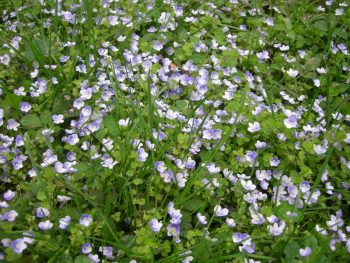

The weed must be removed from the lawn, because it can bring him a lot of various diseases and pests
Weeds can lurk in the soil for many years without losing their germination, and germinate in fertile conditions. They begin to make themselves felt quickly if, for example, organic fertilizers get into the soil during the creation of the lawn. Eventually, birds can also carry weed seeds to the site.
The Legend of St. Veronica
Veronica broadleaf is one of the representatives of the genus Veronica, which includes about 500 species. The stress in the scientific name is put on the 2nd syllable: VeraboutNika.The name of the family is associated with the Christian legend of St. Veronica, who allegedly gave Jesus Christ her handkerchief to wipe his face on his sorrowful journey to Calvary. And delicate thin petals in their color in some plant species seem to be very similar in color to this kind woman's handkerchief.
Read also: Pruning Ficus Rubber Video


This is how the artist El Greco portrayed Saint Veronica, holding a scarf with the imprinted face of Christ in her hands.
Seeds
Sowing of the material is done in late autumn. Flowering occurs 24 months after the planting of filamentous Veronica plants. Seeds in the case of spring sowing lend themselves to stratification - a procedure that consists in creating an artificial temperature difference necessary for normal seed germination.
The process of growing a plant from seeds looks like this:
- Prepare a garden pot with a drainage substrate.
- Seeds are spread on the surface, sprinkled on top with a small amount of earth.
- Crops are sprayed with water. The top is covered with a film with small holes, allowing the seeds to get access to oxygen.
- The pot with planting material is placed in a cooler place in order to create special conditions for seed germination (for example, in a refrigerator), where it is kept for the next 3 weeks.
- After this period, the container is moved to a well-lit warm place and wait for the first shoots, which begin to hatch 2 weeks after the temperature change. They take care of the seedlings according to the standard method.
The seeds of the filamentous veronica are freely available, and you can buy them at any specialized store.
Veronica planting in open ground
Veronica spikelet is an absolutely unpretentious plant, it multiplies easily and grows quickly on the site. The main condition for the successful cultivation of perennials is the correct choice of a planting site and the fulfillment of certain agrotechnical requirements.
When choosing a place for planting, taking into account the photophilousness of the culture, they choose an open and sunny area. Light partial shade is also possible.
Veronica can grow on almost any soil, preferably light and loose loam. One of the main conditions is good soil drainage and the absence of moisture stagnation in the area. Ordinary rubble can be used as drainage. Soil with a neutral or slightly acidic reaction is the best option for a plant.
A drought-resistant plant, Veronica, tolerates short-term drought better than excessive moisture. Excess or permanent stagnation of moisture can be detrimental to the crop.
A hardy and vigorous plant, it is resistant even to trampling. If you step on the bushes of Veronica, they quickly recover and raise the leaves.
Planting seedlings of Veronica in the ground
carried out in the spring in a previously prepared soil (fertilization, drainage, loosening). The holes or grooves are dug shallow, according to the size of the root system of the seedlings. When planting seedlings of Veronica in open ground, leave a distance of about 50 cm between the plants, taking into account the future growth and branching of the bushes. The planting site is spilled with water and the plants are planted in the ground.
Veronica outdoor care
The unpretentious Veronica is convenient in that it requires minimal care and attention, practically does not get sick and does not need additional feeding and winter shelter.
Watering
carried out as needed, without moisture stagnation. It is especially important to moisten the soil before the flowering period and at the stage of seedling germination. The rest of the time, watering is moderate, not frequent. Veronica tolerates short-term drought well.
Mulching
soil around the plant, will allow you to maintain a moderate moist soil microclimate for a longer time without additional watering. In addition, the mulch layer prevents the growth of weeds in the flower bed.
With sufficiently fertile soil, in additional dressing
, culture does not need.In poor soils, it is better to apply mineral and organic fertilizers.
If the varieties of Veronica spicata are tall enough, it is necessary tie a plant
to the support.
Every 5 years you need rejuvenate the veronica bush
dividing it into several parts. Delenki will be able to actively develop and grow "with renewed vigor."
For winter
, the plant does not need to be covered with anything, it perfectly tolerates low temperatures, and even harsh Russian winters.
Features of Veronica's agricultural technology: growing and care
Veronica is loved by gardeners for her unpretentiousness, lack of special techniques, variety of species and varieties. If Veronica is chosen as a resident of a flower bed, then you should remember the basic rules for any perennial plant.
Important requirements that cannot be circumvented:
- Sunny side of the site, where the light will be present from morning to evening. Shady and semi-shaded areas will not give those decorative properties that are declared by breeders.
- Pay attention to watering: each species requires a certain amount of water. When breeding Veronica, you need to get acquainted not only with the decorative value, but also with the conditions of care. Herbaceous creeping species do not tolerate drought, die without water, flowering ceases. Erect tall species can easily withstand drought and heat.
- Liquid organic fertilizers act as top dressing during the period of budding and flowering. In nature and wild breeding, it does well without additional feeding. Soil nutrients are sufficient for growth and flowering. Beds with depleted soil can be fed with organic matter: humus, manure, infusion of nettle and burdock.
- Tall bushes need a garter. A thin stem does not withstand the pressure of the wind, which can not only tilt downward, depriving the aesthetic appearance, but also break. Twigs, picket fence, willow branches will do.
- In autumn, after the end of flowering, the ground part is cut off, the roots are additionally covered with humus, peat, dry foliage, spruce branches, creating a pillow that will protect against abnormally low temperatures.
An excerpt characterizing Veronica armenian
On the square where the emperor went, stood face to face on the right, a battalion of the Transfigurations, on the left, a battalion of the French guard in bear hats. While the sovereign was driving up to one flank of the battalions who were on guard, another crowd of horsemen jumped up to the opposite flank, and in front of them Rostov recognized Napoleon. It couldn't be anyone else. He rode at a gallop in a small hat, with an Andreevskaya ribbon over his shoulder, in a blue uniform open over a white camisole, on an unusually thoroughbred Arabian gray horse, on a crimson, gold embroidered saddle-cloth. Having approached Alexander, he raised his hat and with this movement Rostov's cavalry eye could not fail to notice that Napoleon was badly and not firmly on his horse. The battalions shouted: Hurray and Vive l'Empereur! [Long live the Emperor!] Napoleon said something to Alexander. Both emperors dismounted and took each other's hands. There was an unpleasantly feigned smile on Napoleon's face. Alexander said something to him with an affectionate expression. Rostov did not take his eyes off, despite the trampling of the horses of the French gendarmes, who were beating down the crowd, watched every movement of the Emperor Alexander and Bonaparte. He, as a surprise, was struck by the fact that Alexander behaved as an equal with Bonaparte, and that Bonaparte was completely free, as if this closeness with the sovereign was natural and accustomed to him, as an equal, he treated the Russian tsar. Alexander and Napoleon, with a long tail of their retinue, approached the right flank of the Preobrazhensky battalion, right into the crowd that was standing there. The crowd suddenly found itself so close to the emperors that Rostov, who was standing in the front ranks of it, was afraid that they would not recognize him.- Sire, je vous demande la permission de donner la legion d'honneur au plus brave de vos soldats, [Sovereign, I ask you for permission to give the Order of the Legion of Honor to the bravest of your soldiers,] - said a sharp, precise voice, finishing every letter ... This was said by the small Bonaparte, from below, looking straight into the eyes of Alexander. Alexander listened attentively to what was said to him, and bowing his head, smiled pleasantly. - A celui qui s'est le plus vaillament conduit dans cette derieniere guerre, [To the one who showed himself bravest during the war,] - added Napoleon, rapping out every syllable, with outrageous calmness and confidence for Rostov, looking around the ranks of Russians stretched out before him soldiers, keeping everything on guard and motionlessly looking into the face of their emperor. - Votre majeste me permettra t elle de demander l'avis du colonel? [Your Majesty will allow me to ask the colonel's opinion?] - said Alexander and took several hasty steps towards Prince Kozlovsky, the battalion commander. Bonaparte, meanwhile, began to remove the glove from his white, small hand and, tearing it apart, threw it away. The adjutant, hurrying forward from behind, lifted her up. - To whom to give? - Emperor Alexander asked Kozlovsky not loudly, in Russian. - Whom do you command, your majesty? - The Emperor frowned in displeasure and, looking around, said: - Why, you must answer him. Kozlovsky looked back at the ranks with a resolute air, and in this glance captured Rostov as well.
Taxonomy [edit | edit code]
View Veronica broadleaf
belongs to the genus Veronica (
Veronica
) of the plantain family (
Plantaginaceae
) of the order of Lighthouse (
Lamiales
).
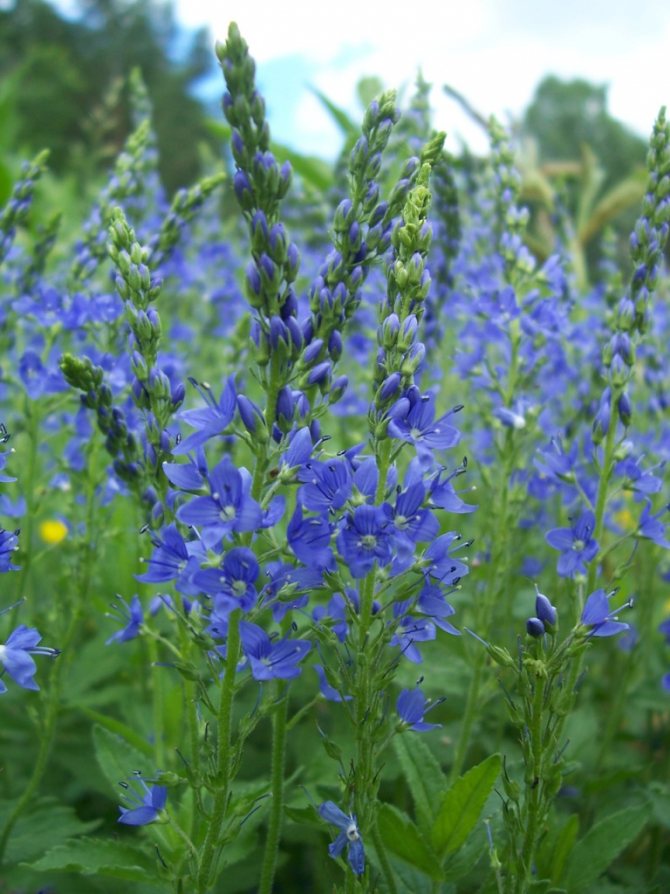

Scientific name: Veronica Dubrovnik, V. large, V. broad-leaved (Veronica teucrium)
Family: Scrophulariaceae
Life form: perennial herb
Sizes: 15 - 100 cm
Bloom time: May - July
Habitat: forest meadows, forest edges, shrubs, light forests.
Features of caring for the area where filamentous grass grows
Veronica can be easily harvested by hand if the plant grows too large or simply becomes unnecessary. There should be no problems with cleaning the lawn, except that Veronica has been growing there for more than one year and her roots are too intertwined. Then you will have to use garden tools, removing flowers along with the top layer of soil. Carrying out such work, it is necessary to ensure that not a single shoot of the filamentous or creeping Veronica remains in the soil, the photo of which can be seen in the article, otherwise the extremely fast growing flowers will again fill the entire area.
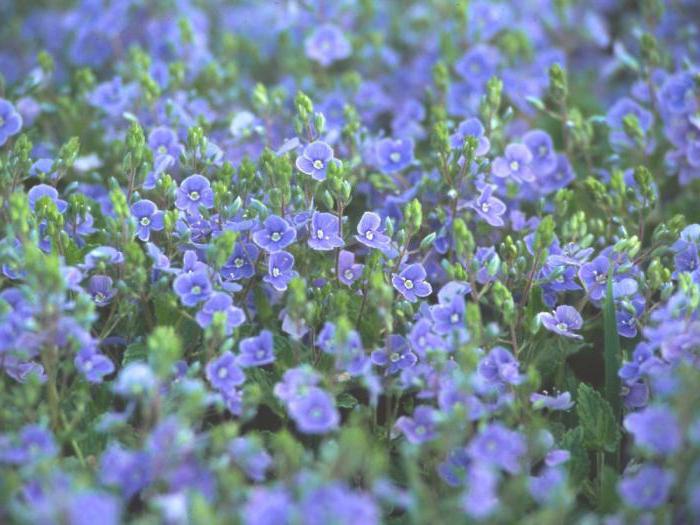

Using such a plant as a landscape decoration will add tenderness and ease to the site. Such a lawn or garden will look spectacular, and individual landscape compositions will be complete. By caring for and observing the growth of the grass, you can control it, creating an amazingly beautiful composition.
Agrotechnics
The plant is unpretentious, therefore, special skills in growing these flowers are not required. Veronica filamentous (or creeping) is able to adapt to growing in any conditions. The grass is unpretentious to the ground. Most species of Veronica are moisture-loving plants, but they take a short drought calmly and easily tolerate it.
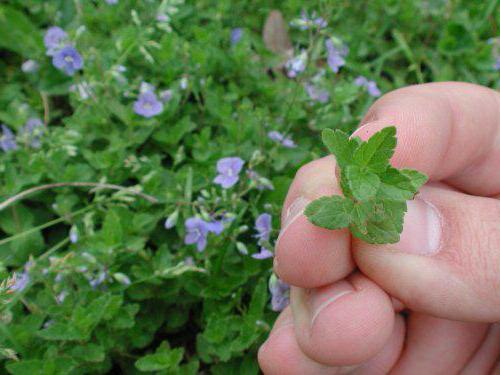

In Russia, the plant easily survives, being frost-resistant and easily tolerating severe Russian frosts. Although some of the species are more delicate, for example, Veronica branched. There is a need to cover them for the winter with spruce branches.
Important! Shoots are cut and removed only after the plant has flowered.
After planting the plants, periodically weed the flowers, otherwise they will run wild. Fertilize Veronica twice a season.
Planting and reproduction of flowers veronica
Veronica is usually propagated in three well-known ways: seeds, dividing the bush and cuttings.
Each of these methods requires attention and adherence to the rules and a certain sequence. You can use any of the available methods.
Consider the most common breeding method for Veronica - how to properly plant a given crop with seeds
... Seed propagation allows you to get a large number of plants.
It is desirable that the seeds are fresh, of good quality, healthy, genetically pure and, accordingly, have good germination. Before sowing, add a little water at room temperature.
Place the seeds at a distance of 2 - 5 cm from each other, sprinkle with earth.
Veronica requires sowing her seeds to a depth of about 3 cm. Next, cover with plastic wrap or a plastic lid.
Then we closely monitor the soil moisture. The soil should never dry out.
Soil moisture is checked daily. To avoid the formation of fungi, make some holes in the lid to ventilate the air. The germination time depends on the size of the seeds and the variety of Veronica.
Dividing the bush
For Veronica flowers, dividing the bush involves completely digging up the plant and dividing it into two or more parts.
This practice is usually carried out by gardeners to keep plants healthy and to create additional supply.
Perennial flowers, such as veronica, tolerate such shock treatments favorably. Veronica bushes are divided every 4 years, or when the plants are overgrown. The procedures are carried out in the fall.
Dividing a plant is easy: just dig up the entire root and then carefully divide it into several sections, depending on the size of the rhizome.
You can cut the roots with a garden knife or an old kitchen knife. Then shake off excess soil and remove any dead pieces. Transplant new young plants directly into open soil or large pots.
Important!
After separation, the roots may be damaged and the flowers generally weakened. Therefore, despite the endurance of Veronica, new plants need good feeding. Dig a hole larger than the root, apply soft compost and fertilizer mixture. Place the plant in a hole, cover with earth and compact. Remember to water intensively and regularly.
Cuttings
This method is most often used if they want to get uniform specimens of a plant, multiply and preserve the species and varieties they like.
In addition, young seedlings bloom earlier when grown by cuttings than when grown with seeds.
The works are carried out in early spring. Several shoots are cut from the central trunk of the plant. Cuttings must be cut with a sharp knife so as not to damage the tissue. The length of cuttings cut is on average about 5 - 10 cm.
Next, place the cuttings 2 cm deep in pots with loose, moist soil (the best option would be a mixture of peat and sand
). Cover the Veronica seedlings with plastic wrap or a plastic lid and place in a warm place for 6 weeks.
Rooted cuttings are planted in pots. Keep the pots in a bright, cool area. Avoid direct sunlight. Plants need to be ventilated and watered periodically.
Within two weeks, the young seedlings have roots. It's time to take cover pictures. Gradually accustom new plants to sunlight. With the onset of stable heat, in May or June, plants can already be transplanted into open ground to a permanent place.
Important!
Keep young Veronica plants in well-moisturized soil. Watch for regular watering before the bushes harden. Older plants are somewhat more resistant to drought. Veronica does not need any special feeding other than a light layer of compost in the spring.

